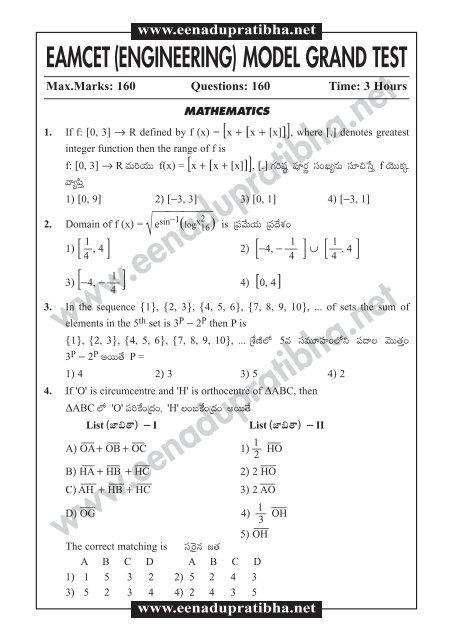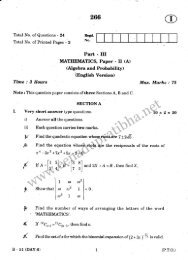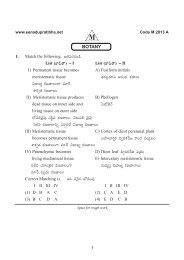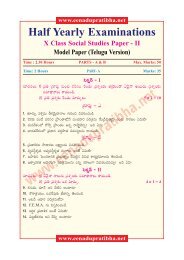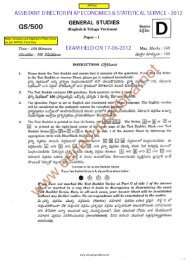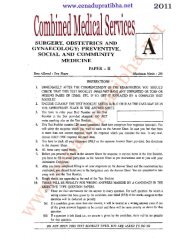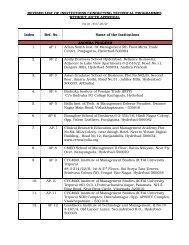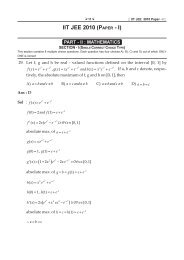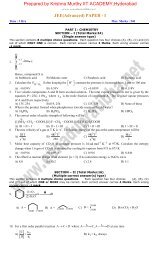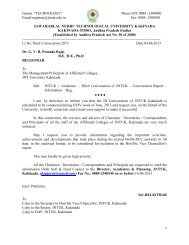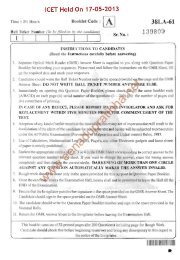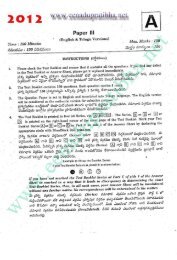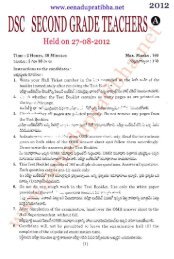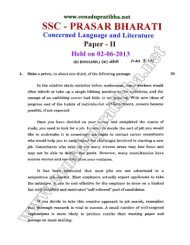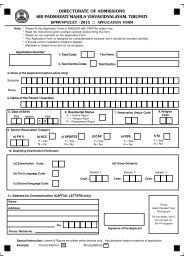R - eenadu pratibha
R - eenadu pratibha
R - eenadu pratibha
Create successful ePaper yourself
Turn your PDF publications into a flip-book with our unique Google optimized e-Paper software.
EAMCET (ENGINEERING) MODEL GRAND TEST<br />
Max.Marks: 160 Questions: 160 Time: 3 Hours<br />
MATHEMATICS<br />
1. If f: [0, 3] →R defined by f (x) = [x + [x + [x]]], where [.] denotes greatest<br />
integer function then the range of f is<br />
f: [0, 3] →R ´’Jߪ· f(x) = [x + [x + [x]]], [.] í∫J≠æe °æ‹®Ωg Ææçêu†’ Ææ÷*ÊÆh f ßÁ·éπ\<br />
¢√u°œh<br />
1) [0, 9] 2) [−3, 3] 3) [0, 1] 4) [−3, 1]<br />
√ ⎯⎯⎯⎯<br />
1 1 1<br />
1) [ ⎯, 4 ] 2)<br />
4 [ −4, −⎯ 4 ] ∪ [ ⎯, 4<br />
4 ]<br />
2. Domain of f (x) = e sin−1 (log x2 16) is v°æ¢Ë’ߪ’ v°æü˨¡ç<br />
1<br />
3) [−4, − ⎯ ] 4) [0, 4]<br />
4<br />
3. In the sequence {1}, {2, 3}, {4, 5, 6}, {7, 8, 9, 10}, ... of sets the sum of<br />
elements in the 5 th set is 3 P − 2 P then P is<br />
www.<strong>eenadu</strong><strong>pratibha</strong>.net<br />
{1}, {2, 3}, {4, 5, 6}, {7, 8, 9, 10}, ... v¨ÏùÀapple 5´ Ææ´‚-£æ«ç-appleE °æü∆© ¢Á·ûªhç<br />
3 P − 2 P Å®·ûË P=<br />
1) 4 2) 3 3) 5 4) 2<br />
4. If 'O' is circumcentre and 'H' is orthocentre of ∆ABC, then<br />
∆ABC apple 'O' °æJ-Íéçvü¿ç, 'H' ©ç•-Íéçvü¿ç -Å®·-ûË<br />
List (-ñ«-G-û√) − I<br />
www.<strong>eenadu</strong><strong>pratibha</strong>.net<br />
1<br />
A) OA ⎯ + OB ⎯ + OC<br />
1) ⎯ HO<br />
2<br />
B) HA ⎯ + HB<br />
+ HC ⎯<br />
2) 2 HO ⎯<br />
C) AH ⎯ + HB ⎯ + HC ⎯ 3) 2 AO<br />
List (-ñ«-G-û√) − II<br />
1<br />
D) OG ⎯ 4) ⎯ OH<br />
⎯<br />
3<br />
5) OH ⎯<br />
The correct matching is<br />
www.<strong>eenadu</strong><strong>pratibha</strong>.net<br />
ÆæÈ®j† ïûª<br />
A B C D A B C D<br />
1) 1 5 3 2 2) 5 2 4 3<br />
3) 5 2 3 4 4) 2 4 3 5<br />
www.<strong>eenadu</strong><strong>pratibha</strong>.net
www.<strong>eenadu</strong><strong>pratibha</strong>.net<br />
5. Assertion (A): The torque about the point 3 ⎯ i − ⎯ j + 3 ⎯ k of a force represented by<br />
4 ⎯ i + 2 ⎯ j + ⎯ k through the point 5 ⎯ i + 2 ⎯ j + 4 ⎯ k is ⎯ i + 2 ⎯ j − 8 ⎯ k.<br />
(A) : 5 ⎯ i + 2 ⎯ j + 4 ⎯ k ≤ƒn†-C-¨¡í¬ Ö†o Gçü¿’´¤ ü∆y®√ ¢Á∞¡⁄h 3 ⎯ i − ⎯ j + 3 ⎯ k<br />
≤ƒn†ÆæC¨¡í¬ Ö†o Gçü¿’´¤ ü¿%≥ƒdu 4 ⎯ i + 2 ⎯ j + ⎯ k •©ç ßÁ·éπ\ ö«®˝\<br />
⎯ i + 2<br />
⎯ j − 8<br />
⎯ k.<br />
Reason (R): The torque of a force F about a point P is ⎯ r × ⎯ F where ⎯ r is the<br />
vector from the point P to any point ⎯ a on the line of action of ⎯ F<br />
(R): F ÅØË •©ç -ßÁ·éπ\ ö«®˝\ P Gçü¿’´¤ ü¿%≥ƒdu ⎯ r × ⎯ F Å´¤-ûª’çC. Ééπ\úø ⎯ r<br />
ÅØËC P Gçü¿’´¤ †’ç* ⎯ a ≤ƒn†- Ææ-C-¨¡í¬ Ö†o Gçü¿’-´¤éÀ UÆœ† ÆæC¨¡<br />
Which of the following is correct?<br />
1) Both A and R are true and R is the correct explanation of A.<br />
A, R ÆæÈ®j-†N, A éÀ R ÆæÈ®j-†- N-´-®Ωù.<br />
2) Both A and R are true but R is not correct explanation of A.<br />
A, R ÆæÈ®j-†N. A éÀ R ÆæÈ®j† N´-®Ωù é¬ü¿’.<br />
3) A is true, but R is false. A Ææûªuç, R ÅÆæûªuç.<br />
4) A is false, but R is true. A ÅÆæûªuç, R Ææûªuç.<br />
www.<strong>eenadu</strong><strong>pratibha</strong>.net<br />
6. Let ⎯ a = ⎯ i + ⎯ j + ⎯ k, ⎯ b = x 1<br />
⎯ i + x2<br />
⎯ j + x3<br />
⎯ k, where x1 , x 2 , x 3 ∈{−3, −2, −1, 0,1, 2}<br />
then the number of possible vectors ⎯ b such that ⎯ a. ⎯ b = 0 are<br />
⎯a = ⎯ i + ⎯ j + ⎯ k, ⎯ b = x 1<br />
⎯ i + x2<br />
⎯ j + x3<br />
⎯ k, x1 , x 2 , x 3 ∈{−3, −2, −1, 0, 1, 2} -Å®·-ûË<br />
⎯ a.<br />
⎯ b = 0 ÅßË’u Nüµ¿çí¬ ≤ƒüµ¿u-´’ßË’u ⎯ b ÆæC-¨¡© Ææçêu<br />
1) 5 2) 10 3) 25 4) 1<br />
7. If ⏐ ⎯ a ⏐ = 3,⏐ ⎯ b ⏐ = 4 and ⏐ ⎯ a + ⎯ b ⏐ = 5 then ⏐ ⎯ a − ⎯ b ⏐ =<br />
⏐ ⎯ a ⏐ = 3,⏐ ⎯ b ⏐= 4, ⏐ ⎯ a + ⎯ b ⏐ = 5 Å®·ûË ⏐ ⎯ a − ⎯ b ⏐ =<br />
1) 5 2) 3 3) 1 4) 0<br />
8. If P is real and ⎯ a = P ⎯ i + sinθ ⎯ j + ⎯ k, ⎯ b = 2 ⎯ i + P ⎯ j + ⎯ k, ⎯ c = ⎯ i + ⎯ j + ⎯ k are three<br />
coplanar vectors then P =<br />
P äéπ ¢√Ææh´ Ææçêu, ⎯ a = P ⎯ i + sinθ ⎯ j + ⎯ k, ⎯ b = 2 ⎯ i + P ⎯ j + ⎯ k, ⎯ c = ⎯ i + ⎯ j + ⎯ k Ææûª-Mߪ’<br />
ÆæC-¨¡©’ Å®·-ûË P=<br />
9.<br />
www.<strong>eenadu</strong><strong>pratibha</strong>.net<br />
1) 1 2) −1 3) 0 4) 3<br />
⎯ a 1 , ⎯ b 1 , ⎯ c 1 are reciprocal vectors of ⎯ a, ⎯ b, ⎯ c then [ ⎯ a 1 ⎯ b 1 ⎯ c 1 ][ ⎯ a ⎯ b ⎯ c ] =<br />
⎯ a 1 , ⎯ b 1 , ⎯ c 1 -©’ ⎯ a, ⎯ b, ⎯ c -ßÁ·éπ\ -Napple´’ ÆæC-¨¡©’ Å®·ûË [ ⎯ a 1 ⎯ b 1 ⎯ c 1 ][ ⎯ a ⎯ b ⎯ c ] N©’´<br />
1) 3 2) 1 3) 13 4) 4<br />
www.<strong>eenadu</strong><strong>pratibha</strong>.net
www.<strong>eenadu</strong><strong>pratibha</strong>.net<br />
10. Which of the following is possible? éÀçC¢√-öÀapple àC ≤ƒüµ¿uç?<br />
1<br />
1) sin θ = x + ⎯ , x ∈ R<br />
x<br />
2) cos θ = x 2 + 2x + 2, x ∈ R<br />
x<br />
3) 2<br />
sec θ = ⎯⎯⎯, x ∈ R<br />
1+ x 2<br />
4) tan θ = −500π<br />
11. sin 2 α + cos 2 (α + β) + 2 sinα sin β cos (α + β) =<br />
1) sin 2 α 2) sin 2 β 3) cos 2 α 4) cos 2 β<br />
B + 2C + 3A A−B<br />
12. In ∆ABC (apple) cos (⎯⎯⎯⎯⎯) + cos (⎯⎯) = ..<br />
2 2<br />
1) −1 2) 1 3) 0 4) 2<br />
13. The maximum value of cos 3 A + cos 3 (120° −A) +cos 3 (120° +A) is<br />
cos 3 A + cos 3 (120° −A) +cos 3 (120° +A) ßÁ·éπ\ í∫J≠æe N©’´<br />
3 4 1 1<br />
1) ⎯ 2) ⎯ 3) ⎯ 4) ⎯<br />
4 3 2 4<br />
14. Period of cos (cos x) +cos (sin x) is<br />
www.<strong>eenadu</strong><strong>pratibha</strong>.net<br />
cos (cos x) +cos (sin x) ßÁ·éπ\ Ç´-®Ωh†ç<br />
π π 2π<br />
1) ⎯ 2) 2π 3) ⎯ 4) ⎯<br />
2 4 3<br />
5 11<br />
√ ⎯⎯ 61 60<br />
5 11<br />
2 sin −1 ( ⎯ ) + tan−1 ( ⎯ ) ßÁ·éπ\ N©’´=<br />
√ ⎯⎯ 61 60<br />
15. The value of 2 sin −1 ( ⎯ ) + tan−1 ( ⎯ ) =<br />
π π π<br />
1) ⎯ 2) ⎯ 3) ⎯ 4) none of these àD-é¬ü¿’<br />
4 2 3<br />
√ ⎯⎯ √ ⎯⎯ π<br />
16. The number of real solutions of tan −1 x(x + 1) +sin −1 x 2 + x + 1 = ⎯ is<br />
2<br />
√ ⎯⎯ √ ⎯⎯ π<br />
tan −1 x(x + 1) +sin −1 x 2 + x + 1 = ⎯ ßÁ·éπ\ ¢√Ææh´ ≤ƒüµ¿--†© Ææçêu<br />
2<br />
1) 0 2) 1 3) 2 4) infinite<br />
www.<strong>eenadu</strong><strong>pratibha</strong>.net<br />
17. If sinx sinhy = cosθ and (´’Jߪ·) cosx coshy = sinθ then (Å®·ûË)<br />
cos h 2 y + cos 2 x =<br />
1) −1 2) 0 3) 1 4) 2<br />
www.<strong>eenadu</strong><strong>pratibha</strong>.net
18. A man on the top of a 100 meters high tower seen a car moving towards the tower<br />
at an angle of 30°. After some time the angle of depression becomes 60°. Then<br />
the distance travelled by the car is<br />
äéπ ´’E≠œ 100 O’. áûª’happle Ö†o Pê®Ωç †’ç* Pê®Ωç ¢Áj°æ¤ ´Ææ’h†o é¬®Ω’†’ 30° éÓùçapple<br />
îª÷¨»úø’. éÌç-ûª Æ洒ߪ’ç ûª®√yûª Ç E´’o-éÓùç 60° Öçõ‰ é¬®Ω’ v°æߪ÷-ùÀç-*† ü¿÷®Ωç<br />
200 √ ⎯ 3 100 √ ⎯ 3<br />
1) 100 √ ⎯ 3 2) ⎯⎯⎯ 3) ⎯⎯⎯ 4) 200 √ ⎯ 3<br />
3 3<br />
1° 1°<br />
19. If base angles of triangle are 22 ⎯, 112 ⎯ then base and height are in the ratio<br />
2 2<br />
1° 1°<br />
äéπ vAµº’ï µº÷N’, éÓù«©’ 22 ⎯, 112 ⎯ Å®·ûË ü∆E µº÷N’éÀ, áûª’h-èπ◊ Ö†o E≠æpAh<br />
2 2<br />
1) 1 : 2 2) 1 : 3 3) 3 : 1 4) 2 : 1<br />
20. In ∆ABC, if the line joining orthocentre and centroid is parallel to ⎯ BC, then<br />
cot B. cot C =<br />
ABC vAµº’-ïçapple ©ç•-Íéç-vü∆Eo, í∫’®Ω’-ûªy-Íéç-vü∆Eo éπLÊ° Í®ê ⎯ BC éÀ Ææ´÷ç-ûª-®Ωçí¬ Öçõ‰<br />
cot B.cot C ßÁ·éπ\ N©’´<br />
1 1<br />
1) ⎯ 2) 2 3) ⎯ 4) 3<br />
2 3<br />
2<br />
z = 2 then the greatest value of ⏐z⏐ is<br />
2<br />
⎥ z − z<br />
⎯ ⎥<br />
= 2 Å®·ûË ⏐z⏐ ßÁ·éπ\ í∫J≠æe N©’´<br />
1) √ ⎯ 3 – 1 2) √ ⎯ 3 3) √ ⎯ 3 + 1 4) √ ⎯ 3 + 2<br />
www.<strong>eenadu</strong><strong>pratibha</strong>.net<br />
21. If ⎥ z − ⎯ ⎥<br />
www.<strong>eenadu</strong><strong>pratibha</strong>.net<br />
22. If cos α+cos β+ cos γ=0 = sin α+sin β+sin γ then (Å®·ûË)<br />
cos 2 α+cos 2 β+cos 2 γ =<br />
1) 3 cos (α +β+γ) 2) −3 cos (α +β+γ)<br />
3<br />
3) ⎯<br />
2<br />
1<br />
4) ⎯<br />
2<br />
23. cos 4θ =<br />
1) 8 sin 4 θ−8 sin 2 θ+1 2) 8 cos 4 θ−8 cos 2 θ+1<br />
3) 4 cos 3 θ sin θ−4 cos θ sin 3 θ 4) 2 sin 3 θ+2 cos θ sin 2 θ<br />
www.<strong>eenadu</strong><strong>pratibha</strong>.net<br />
24. If the transformed equation of a curve is X 2 + Y 2 + 4X + 6Y + 12 = 0 when the<br />
axes are translated to the point (2, 3) then the original equation of the curve is<br />
´‚© Gçü¿’-´¤†’ (2, 3) èπ◊ ´÷®Ωaí¬ X 2 + Y 2 + 4X + 6Y + 12 = 0 ÆæO’-éπ-®Ωùç ÅÆæ©’ ®Ω÷°æç<br />
1) x 2 + y 2 + 1 = 0 2) x 2 + y 2 − 1 = 0 3) x 2 − y 2 + 1 = 0 4) x 2 − y 2 − 1 = 0<br />
www.<strong>eenadu</strong><strong>pratibha</strong>.net
www.<strong>eenadu</strong><strong>pratibha</strong>.net<br />
25. A(7, 3), B(−15, 3) are two vertices of a ∆ABC then locus of third vertex 'C' if<br />
cotA + cotB = k, where k is constant is<br />
A(7, 3), B(−15, 3) ©’ vAµº’ïç ABC ßÁ·éπ\ Q®√{©’. cotA + cotB = k (k Æœn®Ω Ææçêu)<br />
Å®·ûË ´‚úÓ Q®Ω{ç 'C' ßÁ·éπ\ Gçü¿’-°æü∑¿ç<br />
1) a line parallel to BC. ⎯ 2) a line perpendicular to BC.<br />
⎯<br />
⎯<br />
BC éÀ Ææ´÷ç-ûª-®Ωçí¬ ÖçúË Ææ®Ω-∞¡-Í®ê<br />
⎯ BC éÀ ©ç•çí¬ ÖçúË Ææ®Ω-∞¡-Í®ê<br />
3) a circle with A, B as ends of diameter. 4) a line parallel to AB.<br />
⎯<br />
A, B ©’ ¢√uÆæç *´-®Ωí¬ ÖçúË ´%ûªh ÆæO’-éπ-®Ωùç<br />
⎯ AB éÀ Ææ´÷ç-ûª-®Ωçí¬ ÖçúË Ææ®Ω-∞¡-Í®ê<br />
26. The equation of perpendicular bisector of a line segment ⎯ A ⎯ B is x − y + 5 = 0.<br />
If A = (1, −2) then AB =<br />
A= (1, − 2), ⎯ A ⎯ B -ßÁ·éπ\ -©ç• Æǽ ’-Cy-êç-úø† Í®ê ÆæO’-éπ-®Ωùç x − y + 5 = 0 Å®·ûË AB =<br />
1) 7 √ ⎯ 2 2) 6 √ ⎯ 2<br />
3) 8 √ ⎯ 2 4) 9<br />
27. If P, Q are two points on the line 3x + 4y + 15 = 0 such that OP = OQ = 9, then<br />
the area of ∆OPQ is<br />
www.<strong>eenadu</strong><strong>pratibha</strong>.net<br />
P, Q ©’ 3x + 4y + 15 = 0 Í®ê°j ÖçúË È®çúø’ Gçü¿’-´¤©’ OP = OQ = 9, Å®·ûË ∆OPQ<br />
¢Áj¨»©uç<br />
1) 6√ ⎯ 2 2) 9 √ ⎯ 2 3) 12√ ⎯ 2 4) 18√ ⎯ 2<br />
28. The length of the intercept on X − axis cut by the pair of lines<br />
2x 2 + 5xy + 3y 2 + 6x + 7y + 1 = 0 is<br />
2x 2 + 5xy + 3y 2 + 6x + 7y + 1 = 0 Ææ®Ω∞¡ Í®ê- ßÁ·éπ\ X − Åçûª®Ω êçúøç §Òúø´¤<br />
1) √ ⎯ 5 2) 2 √ ⎯ 5 3) √ ⎯ 7 4) 2√ ⎯ 7<br />
29. If the slope of one of the lines represented by 2x 2 + 3xy + ky 2 = 0 is 2 then the<br />
angle between pair of lines is<br />
2x 2 + 3xy + ky 2 = 0 Ææ®Ω∞¡ Í®êapplex äéπ Ææ®Ω∞¡ Í®ê ¢√©’ 2 Å®·ûË Ç Í®ê© ´’üµ¿u éÓùç<br />
π π π π<br />
1) ⎯ 2) ⎯ 3) ⎯ 4) ⎯<br />
2 3 6 4<br />
1 1<br />
30. If the direction cosines of a line are ⎯, ⎯, n and n < 0 then n =<br />
3 3<br />
1 1<br />
äéπ Í®ê Cé˙ éÌÂÆj-Ø˛©’ ⎯, ⎯ n, n < 0 Å®·ûË n =<br />
3 3<br />
√ ⎯ 7 7 3 3<br />
1) − ⎯⎯ 2) − ⎯⎯ 3) ⎯⎯ 4) − ⎯⎯<br />
3 3 7 7<br />
www.<strong>eenadu</strong><strong>pratibha</strong>.net<br />
www.<strong>eenadu</strong><strong>pratibha</strong>.net
www.<strong>eenadu</strong><strong>pratibha</strong>.net<br />
31. The distance between the parallel planes<br />
4x − 4y + 2z + 5 = 0, 2x − 2y + z + 3 = 0 is<br />
4x − 4y + 2z + 5 = 0, 2x − 2y + z + 3 = 0 Ææ´÷ç-ûª®Ω ûª«© ´’üµ¿u ü¿÷®Ωç<br />
1) 1 unit 2) 2 units<br />
1<br />
3) ⎯ units<br />
6<br />
4) 3 units<br />
1 3<br />
5 5<br />
respectively then the angle made by the line with Z − axis is<br />
1 3<br />
5 5<br />
32. If a line makes angles cos −1 (⎯), cos −1 (⎯) with X − axis and Y − axis<br />
äéπ-Í®ê X − Åéπ~ç, Y− Åé~¬-©-ûÓ ´®Ω’-Ææí¬ cos −1 (⎯), cos −1 (⎯) éÓù«©’ îËÆæ’hçC.<br />
Å®·ûË ÇÍ®ê Z − Åéπ~çûÓ îËÊÆ éÓùç<br />
1 2 √ ⎯ 3 4<br />
1) cos −1 (⎯) 2) cos −1 (⎯) 3) cos −1 (⎯) 4) cos<br />
5 5 5 −1 (⎯)<br />
5<br />
1 − √ ⎯ x<br />
33. Lt ⎯⎯⎯⎯ =<br />
x→1 (cos −1 x) 2 1 1<br />
1) 1 2) 4 3) ⎯ 4) ⎯<br />
4 2<br />
1 − tanx π π<br />
34. Let f(x) = ⎯⎯⎯, x ≠ ⎯ , x ∈ [0, ⎯].<br />
4x − π 4 2<br />
www.<strong>eenadu</strong><strong>pratibha</strong>.net<br />
π π<br />
If f(x) is continuous in [0, ⎯], then f (⎯) is<br />
2 4<br />
1 − tanx π π π<br />
f(x) = ⎯⎯⎯ , x ≠ ⎯, x ∈ [0, ⎯], f(x) v°æ¢Ë’ߪ’ç [0, ⎯]apple<br />
4x − π 4 π 2<br />
π<br />
ÅN--*a¥-†oç Å®·ûË f (⎯) N©’´<br />
4<br />
1 1<br />
1) 1 2) − ⎯ 3) −1 4) ⎯<br />
2 2<br />
1 + x<br />
√ ⎯⎯ 1 / 2<br />
1 dy<br />
1 − x 2 dx<br />
35. If y = log ( ⎯⎯ ) − ⎯ tan −1 x then (Å®·ûË) ⎯ =<br />
x 2 x 2 x x<br />
1) ⎯⎯ 2) ⎯⎯ 3) ⎯⎯ 4) ⎯⎯<br />
1 + x 4 1 − x 4 1 − x 2 x 2 − 1<br />
www.<strong>eenadu</strong><strong>pratibha</strong>.net<br />
x n + y n<br />
∂U<br />
x e + y e<br />
∂x<br />
1) n 2) e 3) n − e<br />
n<br />
4) ⎯ e<br />
36. If U = log (⎯⎯⎯) then (Å®·ûË) Σ x ⎯ =<br />
www.<strong>eenadu</strong><strong>pratibha</strong>.net
www.<strong>eenadu</strong><strong>pratibha</strong>.net<br />
37. The radius and height of a cylinder are measured as 5 cm, 10 cm respectively and<br />
there is an error of 0.02 in both the measurements. The percentage error in<br />
volume is<br />
äéπ Ææ÷h°æç ¢√u≤ƒ®Ωl¥ç, áûª’h ´®Ω’-Ææí¬ 5 ÂÆç.O’., 10 ÂÆç.O’., OöÀ éÌ©ûªapplex 0.02 üÓ≠æç Öçõ‰<br />
°∂æ’†-°æ-J-´÷-ùçapple ÖçúË üÓ≠æ ¨»ûªç áçûª?<br />
1) 1 2) 0.01 3) 0.001 4) – 1<br />
38. The lengths of tangent, sub tangent, normal and subnormal for the curve<br />
y = x 2 + x − 1 at (1, 1) are A, B, C, D respectively then their increasing order is<br />
y = x 2 + x − 1 ´véπç°j (1, 1) Gçü¿’´¤ ü¿í∫_®Ω UÆœ† Ææp®Ωz Í®ê, Ö°æ-Ææp®Ωz Í®ê, ÅGµ-©ç• Í®ê,<br />
Ö°æ-Å-Gµ-©ç• Í®ê-© §Òúø-´¤©’ A, B, C, D Å®·ûË, -¢√-öÀ N©’-´©’ Ǯӣæ«ù véπ´’çapple....<br />
1) B, D, A, C 2) B, A, C, D<br />
3) A, B, C, D 4) B, A, D, C<br />
39. If a 2 x 4 + b 2 y 4 = c 6 , then the maximum value of xy is<br />
a 2 x 4 + b 2 y 4 = c 6 , Å®·ûË xy í∫J≠æe N©’´<br />
c 3 c 3 c 3 c<br />
1) ⎯⎯ 2) ⎯⎯ 3) ⎯⎯ 4) ⎯⎯<br />
3<br />
2ab √ ⎯ 2ab ab √ ⎯ ab<br />
www.<strong>eenadu</strong><strong>pratibha</strong>.net<br />
40. The relation between displacement 'S' and time 't' of a particle is given by<br />
1<br />
S = 6 t − ⎯ t 2 then its maximum velocity is<br />
2<br />
äéπ éπùç v°æߪ÷-ùÀçîË ü¿÷®Ωç (S), 鬩ç (t) ´’üµ¿u Ææç•çüµ¿ç<br />
1<br />
S = 6 t −⎯ t 2 Å®·ûË ü∆E í∫J≠æe ¢Ëí∫ç<br />
2<br />
1) 1 unit/sec 2) 6 units/sec 3) 3 units/sec 4) 11 units/sec<br />
41. If y = log (x 2 − a 2 ) then (Å®·ûË) y n =<br />
1 1<br />
1) (−1) n−1 { (n − 1) ! ⎯⎯⎯⎯ + ⎯⎯⎯⎯ }<br />
( x − a) n (x + a) n<br />
1 1<br />
2) (−1) n−1 { (n − 1) ! ⎯⎯⎯⎯ − ⎯⎯⎯⎯ }<br />
(x + a) n (x + a) n<br />
www.<strong>eenadu</strong><strong>pratibha</strong>.net<br />
1 1<br />
3) (−1) n−1 { (n − 1) ! ⎯⎯⎯⎯ − ⎯⎯⎯⎯ }<br />
(x − a) n − 1 (x + a) n − 1<br />
1<br />
4) (−1) n−1 n! ⎯⎯⎯⎯⎯<br />
(x 2 − a 2 ) n<br />
www.<strong>eenadu</strong><strong>pratibha</strong>.net
www.<strong>eenadu</strong><strong>pratibha</strong>.net<br />
3 cos x + 2 sin x<br />
42. ∫ ⎯⎯⎯⎯⎯⎯<br />
5 cos x + 4 sin x<br />
dx =<br />
23 2<br />
1) ⎯⎯ x − ⎯⎯<br />
41 41<br />
log ⏐4 sin x + 5 cos x⏐ + c<br />
23x 2<br />
2) ⎯⎯+ ⎯ log ⏐5 cos x + 4 sin x⏐ + c<br />
41 41<br />
2x 23<br />
3) ⎯ + ⎯ log ⏐4 sin x + 5 cos x⏐<br />
41 41<br />
+ c<br />
2 23<br />
4) ⎯ x + ⎯ log ⏐4 sin x + 5 cos x⏐ + c<br />
41 41<br />
43. ∫ (sin (logx) +cos (logx))dx is<br />
1) x cos (log x) +c 2) e x sin (log x) +c<br />
3) x sin (log x) +c 4) e x cos (log x) +c<br />
∫<br />
sec xdx (sec x + tan x)<br />
44. If ⎯⎯⎯⎯⎯ = ⎯⎯⎯⎯⎯ n<br />
+ c, then (Å®·ûË) n =<br />
(sec x + tanx) 5 n<br />
1) − 6 2) − 5 3) 5 4) 4<br />
π / 2<br />
1<br />
45. ∫ ⎯⎯⎯⎯⎯⎯ dx =<br />
0 4cos2 x + 9sin 2 x<br />
1) ⎯<br />
π<br />
2) ⎯<br />
π<br />
3) ⎯<br />
π<br />
4) ⎯<br />
π<br />
4 8 16 12<br />
π / 2<br />
π / 2 I 1<br />
www.<strong>eenadu</strong><strong>pratibha</strong>.net<br />
46. I 1 = ∫ f(sin2x) sin x dx and I 2 = ∫ f (sin2x) cos xdx, then (Å®·ûË) ⎯ =<br />
0 0 I 2<br />
1<br />
1) 1 2) 3) √ ⎯ 2 4) 2<br />
√ ⎯ 2<br />
47. The area in the first quadrant enclosed by the axes, the line x = y √ ⎯ 3 and the<br />
circle x 2 + y 2 = 4 (smaller area) is<br />
x = y √ ⎯ 3 , x2 + y 2 = 4 ©’ Åé~¬-©Â°j îËÊÆ Åûªu©p ¢Áj¨»©uç (¢Á·ü¿öÀ Åéπ~çapple)<br />
1) ⎯<br />
π<br />
2) ⎯<br />
π<br />
3) ⎯<br />
π<br />
4) ⎯<br />
π<br />
2 3 4 6<br />
48. The approximate value of ∫ 3<br />
x 4 dx using Trapezoidal rule and taking six equal<br />
interval is<br />
−3<br />
www.<strong>eenadu</strong><strong>pratibha</strong>.net<br />
-võ„°œ--ñ«-®·-úø-¸ Ææ÷vû√Eo Ö°æ-ßÁ÷-TÆæ÷h, É*a† Åçûª-®√Eo Ç®Ω’ Ææ´÷† µ«í¬-©’í¬ BÆæ’-èπ◊çô÷<br />
∫ 3<br />
−3<br />
x 4 dx ßÁ·éπ\ Öñ«b-®·ç°æ¤ N©’´<br />
1) 11.5 2) 9 3) 115 4) 120<br />
www.<strong>eenadu</strong><strong>pratibha</strong>.net
www.<strong>eenadu</strong><strong>pratibha</strong>.net<br />
49. Solution of the differential equation<br />
dy (x 2 y 2 ) dy 2 (xy) 3 dy 3<br />
x = 1+ [xy ⎯] + ⎯⎯⎯ [⎯] +⎯⎯[ ⎯] + .. is<br />
dx 2! dx 3! dx<br />
⎯]<br />
dy (x 2 y 2 ) dy 2 (xy) 3 dy 3<br />
x = 1+ [xy + ⎯⎯⎯ [⎯⎯] [ ⎯] +⎯⎯ + .. Å´-éπ-©† ÆæO’-éπ-®Ωù ≤ƒüµ¿†<br />
dx 2! dx 3! dx<br />
1) y = ln (x) +C 2) y = (ln x) 2 + C<br />
3) √ ⎯⎯⎯⎯⎯<br />
y = ± (ln x) 2 + C 4) xy = x y + K<br />
50. The differential equation of the curve for which the normal at every point passes<br />
through a fixed point (h, k) is<br />
àüÁjØ√ Gçü¿’´¤ ´ü¿l UÆœ† ÅGµ-©ç• Í®ê (h, k) Gçü¿’´¤ -ü∆y®√ -¢Á-∞Ïh Ç ´véπç Å´-éπ-©† ÆæO’-éπ-®Ωùç<br />
dx<br />
dx<br />
1) y − k = ⎯ (h − x) 2) y − k = ⎯ (x − h)<br />
dy<br />
dy<br />
dy<br />
dy<br />
3) y − k = ⎯ (h − x) 4) y − k = ⎯ (x − h)<br />
dx<br />
dx<br />
dy xlogx 2 + x<br />
51. ⎯ = ⎯⎯⎯⎯⎯⎯<br />
dx siny + y cosy<br />
1) y sin y = x 2 log x + c 2) y sin y = x 2 + c<br />
3) sin y = x 2 log x + c 4) y sin y = x log x + c<br />
52. The values of K for which the equation x 2 + y 2 + z 2 + 4x + 6y + 8z + K = 0<br />
represents a real sphere is<br />
www.<strong>eenadu</strong><strong>pratibha</strong>.net<br />
x 2 + y 2 + z 2 + 4x + 6y + 8z + K = 0 ÆæO’-éπ-®Ωùç äéπ ¢√Ææh´ íÓ∞«Eo Ææ÷*ÊÆh<br />
1) K ≥ 19 2) K ≤ 29 3) K ≥ 39 4) K ≤ 39<br />
53. The pole of a straight line with respect to the circle x 2 + y 2 = a 2 lies on the<br />
circle x 2 + y 2 = 9a 2 . If the straight line touches the circle x 2 + y 2 = r 2 , then<br />
x 2 + y 2 = a 2 ü¿%≥ƒdu Ææ®Ω-∞¡-Í®ê vüµ¿’´ç x 2 + y 2 = 9a 2 ´%ûªhç O’ü¿ ÖçúÕ, Ç Í®ê<br />
x 2 + y 2 = r 2 ´%û√hEo Ææp %PÊÆh<br />
1) 9a 2 = r 2 2) 9r 2 = a 2 3) r 2 = a 2 4) 3r 2 = a 2<br />
54. If A and B are conjugate point w.r.t a circle with centre 'O' and radius 'r', then<br />
AB 2 =<br />
www.<strong>eenadu</strong><strong>pratibha</strong>.net<br />
'O' Íéçvü¿çí¬, 'r' ¢√u≤ƒ®Ωl¥çí¬ Ö†o ´%û√hEéÀ A, B ©’ Ææçߪ·í∫t Gçü¿’-´¤©’ Å®·ûË AB 2 =<br />
1) OA 2 + OB 2 2) OA 2 + OB 2 + 2r 2<br />
3) OA 2 + OB 2 + r 2 4) OA 2 + OB 2 − 2r 2<br />
www.<strong>eenadu</strong><strong>pratibha</strong>.net
www.<strong>eenadu</strong><strong>pratibha</strong>.net<br />
55. If (1, 2), (4, 3) are limiting points of coaxial system then the equation of the circle<br />
in its conjugate system having minimum area is<br />
(1, 2), (4, 3) äéπ Ææ£æ…-éπ~´%ûªh Ææ®Ω-ùÀéÀ Å´Cµ Gçü¿’-´¤©’ Å®·ûË ü∆EéÀ ©ç•-Ææ-£æ…éπ~ ´%ûªh-Ææ-®Ω-ùÀapple<br />
ÅA ûªèπ◊\´ ¢Áj¨»©uç Ö†o ´%ûªh ÆæO’-éπ-®Ωùç<br />
1) x 2 + y 2 − 2x − 4y + 5 = 0 2) x 2 + y 2 − 8x − 6y + 25 = 0<br />
3) x 2 + y 2 − 5x − 5y + 10 = 0 4) x 2 + y 2 + 5x + 5y − 10 = 0<br />
56. The normal at 'P' cuts the axis of the parabola y 2 = 4ax in G and S is the focus<br />
of the parabola. If ∆ SPG is an equilateral then each side is of length<br />
y 2 = 4ax °æ®√-´-©-ߪ÷-EéÀ 'P' Gçü¿’´¤ ´ü¿l UÆœ† ÅGµ-©ç-•-Í®ê -Åé~¬Eo G ü¿í∫_®Ω êçúÕ-Ææ’hçC.<br />
S Ø√Gµ, ∆ SPG Ææ´’-«£æ› vAµº’ïç Å®·ûË -Ç vA-µº’ï µº’ïç §Òúø´¤<br />
1) a 2) 2a 3) 3a 4) 4a<br />
x 2 y 2<br />
57. The ends of minor axis and the Focii of ⎯ + ⎯ = 1 form a square, then its<br />
a 2 b 2<br />
eccentricity is<br />
x 2 y 2<br />
⎯ + ⎯ = 1 -D®Ω`-´%-ûªh Ø√µº’©’ v£æ«≤ƒyéπ~ç -ßÁ·éπ\ Åçû√u©ûÓ äéπ îªûª’-®Ω--vÆæç à®Ωp-úÕ-ûË<br />
a 2 b 2<br />
D®Ω`-´%ûªh ÖûË\ç-vü¿ûª<br />
www.<strong>eenadu</strong><strong>pratibha</strong>.net<br />
1 1 √ ⎯ 3<br />
1) ⎯ 2) 3) ⎯⎯ 4) sin18°<br />
2 √ ⎯ 2 2<br />
x 2 y 2<br />
58. The equation ⎯⎯⎯ + ⎯⎯⎯ = 1 represents a hyperbola then<br />
7 − k 5 − k<br />
x 2 y 2<br />
⎯⎯⎯ + ⎯⎯⎯ = 1 ÅA °æ®√-´©ßª÷Eo Ææ÷*ÊÆh<br />
7 − k 5 − k<br />
1) 5 < k < 7 2) k < 5 (or) k > 7<br />
3) k < 5 4) k ≠ 5, k ≠ 7<br />
(<br />
π<br />
59. The equation of the line which passes through −1, ⎯⎯ ) and which is parallel to<br />
2<br />
r (2cosθ + √ ⎯ 3 sinθ) = 4 is<br />
www.<strong>eenadu</strong><strong>pratibha</strong>.net<br />
π<br />
2<br />
ÆæO’-éπ-®Ωùç<br />
1) r (2 cosθ + √ ⎯ 3 sinθ) = √ ⎯ 3 2) r (2 cosθ + √ ⎯ 3 sinθ) = −√ ⎯ 3<br />
3) r (2 sinθ −√ ⎯ 3 cosθ) = 2 4) r (2 sinθ −√ ⎯ 3 cosθ) = −2<br />
r(2cosθ + √ ⎯ 3 sinθ) = 4 Í®êéÀ Ææ´÷ç-ûª-®Ωçí¬ Öçô÷ ( −1, ⎯⎯ ) Gçü¿’´¤ ü∆y®√ --¢Á-∞Ïx Í®-ë«<br />
www.<strong>eenadu</strong><strong>pratibha</strong>.net
www.<strong>eenadu</strong><strong>pratibha</strong>.net<br />
60. If the roots of 3x 3 − 22x 2 + 48x − 32 = 0 are in H.P., then the roots are<br />
3x 3 − 22x 2 + 48x − 32 = 0 ÆæO’-éπ-®Ωù ´‚«©’ H.P. apple Öçõ‰ Ç ´‚«©’<br />
1 1 3 4<br />
1) ⎯, ⎯, ⎯ 2) 4, 2, ⎯<br />
4 2 4 3<br />
3) ⎯,<br />
1<br />
⎯,<br />
1<br />
⎯<br />
2<br />
4) 3, 2, ⎯<br />
3<br />
3 2 3 2<br />
61. For the equation ⏐x⏐ 2 + ⏐x⏐ −6 = 0, the roots are<br />
⏐x⏐ 2 + ⏐x⏐ −6 = 0 ÆæO’-éπ-®Ωù ´‚«©’<br />
1) one and only one real number 2) real with sum one<br />
äÍé äéπ ¢√Ææh´ Ææçêu<br />
¢√Ææh´ç, ´‚«© ¢Á·ûªhç '1'<br />
3) real with sum zero 4) real with product zero<br />
¢√Ææh-¢√©’, ´‚«© ¢Á·ûªhç'0'<br />
62. If 20 3 − 2x2 = (40√ ⎯ 5) 3x2 − 2 , then (Å®·ûË) x =<br />
¢√Ææh-¢√©’, ´‚«© ©-•l¥ç '0'<br />
√ ⎯⎯ 13<br />
√ ⎯⎯ 12<br />
√ ⎯⎯ 4<br />
√ ⎯⎯ 5<br />
12 13 5 4<br />
1) ± ⎯ 2) ± ⎯ 3) ± ⎯ 4) ± ⎯<br />
www.<strong>eenadu</strong><strong>pratibha</strong>.net<br />
√ ⎯⎯⎯<br />
√ ⎯⎯⎯<br />
63. If x 3 , x 4 , x 5 , ... can be neglected, then x 2 + 16 − x 2 + 9 =<br />
√ ⎯⎯⎯<br />
√ ⎯⎯⎯<br />
x 3 , x 4 , x 5 ,... ©†’ NÆæt-JÊÆh x 2 + 16 − x 2 + 9 =<br />
x 2 x 2 x 2 x 2<br />
1) 1− ⎯ 2) 1 −⎯ 3) 1− ⎯ 4) 1 − ⎯<br />
4 8 18 24<br />
64. In the expansion of (1 + x) n , if the 2 nd , 3 rd terms are respectively a, b then x =<br />
(1 + x) n NÆæh-®Ω-ùapple 2´, 3´ °æü∆©’ ´®Ω’-Ææí¬ a, b©’ Å®·ûË, x =<br />
2b a a 2 a 2 − 2b<br />
1) a − ⎯ 2) ⎯⎯⎯ 3) ⎯⎯⎯ 4) ⎯⎯⎯<br />
a a 2 − 2b a 2 − 2b a 2<br />
x 4 + 3x + 1 C D E<br />
65. If ⎯⎯⎯⎯⎯⎯ = Ax + B + ⎯⎯ + ⎯⎯⎯ + ⎯⎯ then (Å®·ûË) A+ D =<br />
(x + 1) 2 (x − 1) x + 1 (x+1) 2 x − 1<br />
3<br />
1) 2 2) −2 3) ⎯ 4) 0<br />
2<br />
1 2 2 2 3 2 4 2<br />
66. ⎯ + ⎯ + ⎯ + ⎯ + ... ∞ =<br />
3! 4! 5! 6!<br />
www.<strong>eenadu</strong><strong>pratibha</strong>.net<br />
1) 2e − 5 2) 2e − 4 3) 5e + 1 4) e − 1<br />
www.<strong>eenadu</strong><strong>pratibha</strong>.net
67.<br />
x x 2 x 3<br />
⎯ + ⎯ + ⎯ + ...<br />
1.2 2.3 3.4<br />
1 − x x − 1<br />
x<br />
x<br />
1 − x x − 1<br />
x<br />
x<br />
x + 1 x x<br />
1) 1 + ( ⎯⎯ ) log (1 − x) 2) 1 + ( ⎯⎯ ) log (1 − x)<br />
3) 1 + ( ⎯⎯ ) log (x − 1) 4) 1 + ( ⎯⎯ ) log (x − 1)<br />
68. If a ≠ 0<br />
⏐ x x + a x ⏐ x x x + a 2<br />
www.<strong>eenadu</strong><strong>pratibha</strong>.net<br />
= 0 represents (Ñ ÆæO’-éπ-®Ωùç üËEo Ææ÷*-Ææ’hçC)<br />
1) a straight line parallel to X − axis 2) a straight line parallel to Y − axis<br />
X- Åé~¬-EéÀ Ææ´÷ç-ûª-®Ωçí¬ ÖçúË Í®ê Y- Åé~¬-EéÀ Ææ´÷ç-ûª-®Ωçí¬ ÖçúË Í®ê<br />
3) a parabola °æ®√-´-©ßª’ç 4) a circle ´%ûªhç<br />
69. Consider the following statements. éÀçC v°æ´-îª-Ø√-©†’ °æJ-Q-Lç-îªçúÕ.<br />
Statement - I: If det A = 0, then det (adj A) = 0.<br />
v°æ´-îª†ç – I: ⏐A⏐ = 0 Å®·ûË ⏐adj A⏐ = 0.<br />
Statement - II: If A is non-singular then det (A −1 ) = (det A) −1 .<br />
v°æ´-îª†ç – II: A ≤ƒ-üµ∆®Ω-ù --´÷-vAéπ -Å®·-ûË ⏐A −1 ⏐ = ⏐A⏐ −1 .<br />
Which of the above statements is/are correct? °j v°æ´-îªØ√applex ÆæÈ®j-†N àN?<br />
1) Both I and II I -´’-J-ߪ· II 2) Neither I nor II àD- é¬ü¿’<br />
3) I only I ´÷vûª¢Ë’ 4) II only II´÷vûª¢Ë’<br />
www.<strong>eenadu</strong><strong>pratibha</strong>.net<br />
70. If there is no solution for the system of equations x + y + z = 4, y + 2z = 5<br />
and x + y + pz = q<br />
°j ÆæO’-éπ-®Ωù ´u´ÆænéÀ ≤ƒüµ¿† ‰éπ§ÚûË<br />
1) p = 1 and q = 4 2) p = 1 and q ≠ 4 3) p ≠ 1 and q = 4 4) p ≠ 1 and q ≠ 4<br />
71. Number of ways of arranging 3 boys and 4 girls so that no boy is in between any<br />
two girls<br />
-´·í∫’_®Ω’ «©’®Ω’, -†-©’í∫’®Ω’ «L-éπ-©†’ äéπ ´®Ω-Ææapple Å´’Ja†°æ¤púø’ à Éü¿l®Ω’ «L-éπ© ´’üµ¿u<br />
«©’®Ω’ ®√E Å´’-J-éπ© Ææçêu<br />
1) 576 2) 314 3) 144 4) 24<br />
72. In a shop there are 30 Thumsups, 20 Sprites, 40 Limcas. In how many ways a<br />
boy can purchase 10 cool drinks?<br />
www.<strong>eenadu</strong><strong>pratibha</strong>.net<br />
äéπ ü¿’é¬-ùçapple 30 -ü∑¿-´’q°ˇ-©’, 20 -vÂÆjp-ö¸, 40 L-´÷\-©’ ÖØ√o®·. äéπ «©’úø’ 10 Qûª©<br />
§ƒFߪ÷©-†’ éÌØ√-©-†’-èπ◊ç-õ‰ áEo Nüµ∆©’í¬ é̆-í∫-©úø’?<br />
-1) 66 2) 90 C 10<br />
3) 10 C 3<br />
4) 15<br />
www.<strong>eenadu</strong><strong>pratibha</strong>.net
www.<strong>eenadu</strong><strong>pratibha</strong>.net<br />
73. The maximum number of points of intersection of 4 circles and 4 straight lines is<br />
4 ´%û√h©’, 4 Ææ®Ω-∞¡-Í®-ê©’ í∫J-≠æeçí¬ êçúÕç--èπ◊ØË Gçü¿’´¤©’<br />
1) 25 2) 50 3) 56 4) 73<br />
74. If C(2n, 3) : C(n, 2) = 12 : 1 then (Å®·ûË) n =<br />
1) 4 2) 6 3) 5 4) 8<br />
75. A letter is known to have come from either 'LONDON' (or) 'CLIFTON' on the<br />
envelope just 2 consecutive letters 'ON' are visible. The probability that the<br />
letter comes from LONDON<br />
äéπ Öûªh®Ωç 'LONDON' (‰ü∆) 'CLIFTON' †’ç* ´*açC é¬F Ç éπ´-®Ω’°j È®çúø’ ´®Ω’Ææ<br />
°æü∆©’ 'ON' í¬ éπ-E°œÊÆh Ç Öûªh®Ωç LONDON †’ç* ®√´-ú≈-EéÀ Ö†o Ææ絫-´uûª<br />
12 5 3 2<br />
1) ⎯ 2) ⎯ 3) ⎯ 4) ⎯<br />
17 17 17 5<br />
76. Four numbers are chosen at random from {1, 2, 3, ...40}. The probability that<br />
they are not consecutive is<br />
{1, 2, 3,... 40} †’ç* Ø√©’í∫’ Ææçêu-©†’ ߪ÷-ü¿%*a¥éπçí¬ á†’oèπ◊çõ‰ ÅN ´®Ω’Ææ Ææçêu©’<br />
é¬èπ◊çú≈ Öçúø--ö«-EéÀ Ææ絫-´uûª<br />
www.<strong>eenadu</strong><strong>pratibha</strong>.net<br />
1 4 2469 7965<br />
1) ⎯⎯ 2) ⎯⎯⎯ 3) ⎯⎯⎯ 4) ⎯⎯⎯<br />
2470 7969 2470 7969<br />
77. If x is a binomial variate with the range n = 6 and P(x = 2) = 4P (x = 4), then the<br />
parameter P of x is<br />
x ÅØËC Cy°æü¿ Nµ«-ïéπç Å®·u ü∆E ¢√u°œh n = 6, P(x = 2) = 4P(x = 4) Å®·ûË x °æ®√N’A<br />
P N©’´.<br />
1 1 2 3<br />
1) ⎯ 2) ⎯ 3) ⎯ 4) ⎯<br />
3 2 3 4<br />
78. A random variable X has its range {0, 1, 2, 3, ...}.<br />
c(r + 1)<br />
If P(X = r) = ⎯⎯⎯⎯ for r = 0, 1, 2, ... then c =<br />
3 r<br />
x ÅØË ßª÷-ü¿%*a¥éπ -®√P ¢√u°œh {0, 1, 2, 3, ...}<br />
www.<strong>eenadu</strong><strong>pratibha</strong>.net<br />
c(r + 1)<br />
P(X = r) = ⎯⎯⎯⎯, r = 0, 1, 2... Å®·ûË c =<br />
3 r<br />
4 1 1<br />
1) ⎯ 2) ⎯ 3) 2 4) ⎯<br />
9 2 4<br />
www.<strong>eenadu</strong><strong>pratibha</strong>.net
www.<strong>eenadu</strong><strong>pratibha</strong>.net<br />
79. If a random variable X follows poision distribution and its variance (σ 2 ) = 4 then<br />
mean (µ) =<br />
ߪ÷-ü¿%-*a¥éπ -®√P X §ƒ®·-ïØ˛ Eߪ’-´÷Eo §ƒöÀ-Ææ’hçC, ü∆E NÆæh %A (σ 2 ) = 4 Å®·ûË<br />
´’üµ¿u´’ç (µ) =<br />
1) 2 2) √ ⎯ 2 3) 4 4) 1<br />
1<br />
80. Suppose X follows a binomial distribution with parameters n = 100 and P = ⎯ .<br />
3<br />
Then P(X = r) is maximum when r =<br />
ߪ÷-ü∑¿%-*a¥éπ -®√P X Cy°æü¿ N-µ«-ï-Ø√Eo §ƒöÀ-Ææ’hçC.<br />
1<br />
n = 100, P = ⎯, P(X = r) í∫J≠æeç Å®·ûË r N©’´<br />
3<br />
1) 65 2) 67 3) 33 4) 30<br />
PHYSICS<br />
81. The physical quantity having the dimensions [M −1 L −3 T +3 A 2 ]<br />
[M −1 L −3 T +3 A 2 ] N’ûª’©’ Ö†o µ˜Aéπ ®√P<br />
1) resistance E®Óüµ¿ç 2) resistivity E®Óüµ¿éπûª<br />
3) electrical conductivity Nü¿’uû˝ ¢√£æ«-éπûª 4) electromotive force Nü¿’u-î√a¥-©éπ •©ç<br />
82. A swimmer crosses a river of width 'd' flowing at a velocity 'v'. While swimming,<br />
he keeps himself always at an angle of 120° with the river flow and on reaching<br />
the other point he finds a drift of d/2 in the direction of flow of river. The speed<br />
of swimmer with respect to river is<br />
d ¢Áúø©’p ÖçúÕ, 'v' ¢Ëí∫çûÓ v°æ´£œ«Ææ’h†o †CE äéπ ´uéÀh Ñü¿’ûª÷ ü∆ö«úø’. v°æ¢√£æ« C¨¡èπ◊<br />
á©x°æ¤púø÷ 120° éÓùçapple ÑC† Åûªúø’, †CE ü∆öÀ† ûª®√yûª, †C C¨¡apple ûª† N≤ƒn-°æ†ç d/2 í¬<br />
í∫’Jhç-î√úø’. Å®·ûË †C ü¿%≥ƒdu ÑC† ´uéÀh ¢Ëí∫ç?<br />
www.<strong>eenadu</strong><strong>pratibha</strong>.net<br />
1) (2 − √ ⎯ 3)v 2) 2(2 − √ ⎯ 3)v 3) 4(2 − √ ⎯ 3)v 4) (2 + √ ⎯ 3)v<br />
83. A particle is projected from the ground with an initial speed of V at an angle θ<br />
with the horizontal. Average velocity of the particle between its point of<br />
projection and highest point of the trajectory is<br />
äéπ éπù«Eo V ûÌL ´úÕûÓ, éÀ~A-ïçûÓ θ éÓùç îËÊÆ« ØË© †’ç* v°æéÀ~°æhç î˨»®Ω’. v°æéÀ~-°æh-Gçü¿’´¤,<br />
°æü∑¿çapple í∫J≠æe áûª’h ´’üµ¿u éπùç Ææí∫ô’ ¢Ëí∫ç<br />
www.<strong>eenadu</strong><strong>pratibha</strong>.net<br />
V ⎯⎯⎯⎯⎯ V ⎯⎯⎯⎯⎯<br />
1) ⎯<br />
√ 1 + 2 cos2 θ 2) ⎯<br />
√ 1 + cos2 θ<br />
2 2<br />
V ⎯⎯⎯⎯⎯<br />
3) ⎯<br />
√ 1 + 3cos2 θ 4) V cos θ<br />
2<br />
www.<strong>eenadu</strong><strong>pratibha</strong>.net
84. Two blocks of masses 5 kg and 2 kg are connected by a massless<br />
string as shown in the figure. A vertical force F is applied on the<br />
5 kg block. The value of F if tension in the string connecting the<br />
blocks is 40 N is (g = 10 ms −2 )<br />
°æôçapple îª÷°œ†ô’x 5 kg, 2 kg vü¿´u-®√P Ö†o È®çúø’ C¢Á’t-©†’ vü¿´u-®√-P- 2 kg<br />
®Ω-£œ«ûª ü∆®ΩçûÓ éπL§ƒ®Ω’. 5 kg © C¢Á’t°j Eôd-E-©’-´¤í¬ °jéÀ F •«Eo v°æßÁ÷-Tç-*-†-°æ¤púø’, C¢Á’t-<br />
©†’ éπ©’-°æ¤-ûª’†o ü∆®Ωçapple ûª†uûª 40 N Å®·ûË, F N©’´<br />
1) 140 N 2) 70 N 3) 40 N 4) 100 N<br />
85. In inelastic collision of two bodies which of following do not change after the<br />
collision<br />
È®çúø’ ´Ææ’h-´¤© ÅÆœn-A-≤ƒn-°æéπ ÅGµ-°∂æ÷-ûªçapple, ÅGµ-°∂æ÷ûªç ûª®√yûª éÀçC-¢√-öÀapple àC ´÷®Ωü¿’?<br />
a) total kinetic energy b) total linear momentum<br />
¢Á·ûªhç í∫A-¨¡éÀh<br />
¢Á·ûªhç Í®&ߪ’ vü¿´u-¢Ëí∫ç<br />
c) total energy d) total angular momentum<br />
¢Á·ûªhç ¨¡éÀh<br />
www.<strong>eenadu</strong><strong>pratibha</strong>.net<br />
¢Á·ûªhç éÓùÃߪ’ vü¿´u-¢Ëí∫ç<br />
1) a & b 2) b & c 3) b & d 4) a & d<br />
86. A force F acting on a body depends on its displacement S as F ∝ S −1/3 . The<br />
power delivered by F will depends on displacement as.<br />
www.<strong>eenadu</strong><strong>pratibha</strong>.net<br />
´Ææ’h´¤ O’ü¿ °æE îËÆæ’h†o •©ç F, ≤ƒn†-vµºç¨¡ç S O’ü¿ F ∝ S −1/ 3 í¬ Çüµ∆-®Ω-°æ-úø’-ûª’çC. F ´©x<br />
Núø’-ü¿-„j† ≤ƒ´’®Ωnuç, ≤ƒn†-vµºç¨¡çO’ü¿ ÑN-üµ¿çí¬ Çüµ∆-®Ω-°æ-úø’-ûª’çC<br />
1) S 2/3 2) S −3/2 3) S 1/2 4) S 0<br />
87. From a circular disc of radius R, a square is cut out with a radius as its diagonal.<br />
The centre of mass of remainder is at a distance (from the centre)<br />
R ¢√u≤ƒ®Ωl¥ç Ö†o ´%û√h-é¬®Ω úÕÆæ’\ †’ç*, ¢√u≤ƒ®Ωl¥ç, éπ®Ωgçí¬ äéπ îªûª’-®Ω-v≤ƒEo éπAhJçî√®Ω’.<br />
N’TL† µ«í∫ç ßÁ·éπ\ vü¿´u-®√P Íéçvü¿ ü¿÷®Ωç (Íéçvü¿ç †’ç*)<br />
R R R R<br />
1) ⎯⎯⎯ 2) ⎯⎯ 3) ⎯⎯⎯ 4) ⎯⎯⎯<br />
(4π − 2) 2π (π − 2) (2π − 2)<br />
88. A block is allowed to slide down an inclined plane of 45° which is smooth for<br />
first 9/25 of total length and it is rough for remaining part. Initially it starts from<br />
rest and comes to rest at the bottom of plane. Then coefficient of friction between<br />
the surfaces is<br />
www.<strong>eenadu</strong><strong>pratibha</strong>.net<br />
45°¢√©’†o ¢√©’-ûª©ç °j†’ç* äéπ C¢Á’t ñ«®Ω’ûÓçC. ¢√©’-ûª©ç ¢Á·ûªhç §Òúø-´¤apple 9/25<br />
´çûª’ †’†’°æ¤ ûª©ç, N’í∫-û√C í∫®Ω’èπ◊ ûª©ç. ûÌLí¬ ÉC N®√-´’-ÆœnA †’ç* •ßª’-©’-üËJ, éÀçC<br />
µ«í¬-EéÀ îËÍ®Ææ-JéÀ N®√-´’-Æœn-AéÀ ´Ææ’hçC. ûª«© ´’üµ¿u °∂æ’®Ω{ù í∫’ùéπç<br />
25 16 9 25<br />
1) ⎯ 2) ⎯ 3) ⎯ 4) ⎯<br />
16 25 25 9<br />
www.<strong>eenadu</strong><strong>pratibha</strong>.net<br />
5 kg<br />
F
www.<strong>eenadu</strong><strong>pratibha</strong>.net<br />
89. The energy required to shift a satellite from orbital radius 'r' to 2r radius is 'E'.<br />
What energy will be required to shift the satellite from orbital radius '2r' to orbital<br />
radius '3r'?<br />
äéπ Ö°æ-ví∫-£æ…Eo r ¢√u≤ƒ®Ωl¥ç †’ç* 2r ¢√u≤ƒ®√l¥EéÀ ≠œ°∂ˇd îËߪ’ú≈-EéÀ 鬢√Lq† ¨¡éÀh 'E'. '2r'<br />
¢√u≤ƒ®Ωl¥ç †’ç* 3r ¢√u≤ƒ®√l¥EéÀ ≠œ°∂ˇd îËߪ’ú≈-EéÀ 鬢√Lq† ¨¡éÀh<br />
E E E<br />
1) E 2) ⎯ 3) ⎯ 4) ⎯<br />
2 3 4<br />
90. F−x and x−t graph of a particle in SHM are as shown in Fig. The maximum K.E.<br />
of particle is<br />
Ææ.£æ«.-îª.apple Ö†o éπùç ßÁ·éπ\ F − x, x − t ví¬°∂椩†’ °æôçapple îª÷°œçî√®Ω’. éπùç í∫J≠æe<br />
í∫A﨡éÀh<br />
-1<br />
F (N)<br />
10<br />
x (m)<br />
www.<strong>eenadu</strong><strong>pratibha</strong>.net<br />
1) 16 mJ 2) 8 mJ<br />
3) 26 mJ 4) 0.8 mJ<br />
91. A wire of length 1 m and radius 1 mm is subjected to a load. The extension is 'x'.<br />
The wire is melted and then drawn into a wire of square cross−section of side 1<br />
mm. What is its extension under the same load?<br />
1 m §Òúø´¤, 1 mm ¢√u≤ƒ®Ωl¥ç Ö†o Bí∫èπ◊ µ«®√Eo Ææçüµ∆-Eç-î√®Ω’. ≤ƒí∫’-ü¿© 'x'. Bí∫†’ éπJ-Tç*,<br />
ûª®√yûª ü∆Eo 1 mm µº’ïç §Òúø´¤†o îªûª’-®ΩvÆæ ´’üµ¿u-îËa¥-ü¿çí¬ ´’Lî√®Ω’. ÅüË µ«®√-EéÀ ≤ƒí∫’-ü¿©<br />
1) π 2 x 2) πx 2<br />
3) πx 4) π/x<br />
4<br />
x (cm)<br />
92. Drops of liquid of density d are floating half immersed in a liquid of density ρ.<br />
If the surface tension of liquid is T then the radius of the drop will be<br />
(d = density of liquid drop)<br />
d ≤ƒçvü¿ûª Ö†o vü¿´-Gç-ü¿’-´¤©’, ρ ≤ƒçvü¿ûª Ö†o vü¿´çapple Ææí∫ç ´·EÍí« ûË©’ûª’-Ø√o®·. vü¿´<br />
www.<strong>eenadu</strong><strong>pratibha</strong>.net<br />
ûª©-ûª-†uûª T Å®·ûË, vü¿´ ¢√u≤ƒ®Ωl¥ç (d = vü¿´-Gç-ü¿’´¤ ≤ƒçvü¿ûª)<br />
⎯⎯⎯⎯ ⎯⎯⎯⎯ ⎯⎯⎯⎯ ⎯⎯⎯⎯<br />
3T 6T 2T 3T<br />
1) ⎯⎯⎯⎯ 2) ⎯⎯⎯⎯ 3) ⎯⎯⎯⎯ 4) ⎯⎯⎯⎯<br />
√ g(2d − ρ) √ g(2d − ρ) √ g(2d − ρ) √ g(4d − 3ρ)<br />
www.<strong>eenadu</strong><strong>pratibha</strong>.net<br />
4<br />
5<br />
t(s)
www.<strong>eenadu</strong><strong>pratibha</strong>.net<br />
93. A semicircular plate of mass 'm' has radius 'r' and centre 'C'. Its centre of mass is<br />
at a distance x from C. Its moment of inertia about an axis through its centre of<br />
mass and perpendicular to its plane is<br />
äéπ Å®Ωl¥ ´%û√h-é¬®Ω °æ∞Îx°æ¤ vü¿´u-®√P 'm', ¢√u≤ƒ®Ωl¥ç 'r', Íéçvü¿ç 'C'. Íéçvü¿ç 'C' †’ç* ü∆E vü¿´u-<br />
®√P Íéçvü¿ç x ü¿÷®Ωçapple ÖçC. Å®·ûË vü¿´u-®√P Íéçvü¿ç ü∆y®√ ¢Á∞¡⁄h ûª«-EéÀ ©ç•çí¬ ÖçúË<br />
Åéπ~-°æ-®Ωçí¬ ü∆E ïúøûªy vµ«´’éπç<br />
mr 2 mr 2 mr 2 mr 2<br />
1) ⎯ 2) ⎯ 3) ⎯ + mx 2 4) ⎯ − mx 2<br />
2 4 2 2<br />
94. A string is wrapped several times around a solid cylinder and the free end of<br />
string is held stationary while the horizontal cylinder is released from rest. The<br />
tension in the string will be<br />
°∂æ’†-Ææ÷h°æç ô÷d, ûªçvAE î√« ô’xí¬ îª’ö«d®Ω’. ûªçvA ÊÆyî√a¥ *´-®Ω†’ Æœn®Ωçí¬ Öçî√®Ω’.<br />
Ææ÷h§ƒEo N®√´’-ÆœnA †’ç* Núø’-ü¿© îËÊÆh, ûªçvAapple ûª†uûª<br />
mg mg mg 2mg<br />
1) ⎯ 2) ⎯ 3) ⎯ 4) ⎯<br />
3 2 4 3<br />
95. There are two holes one each along the opposite sides of a wide rectangular tank.<br />
The cross section of each hole is 0.01 m 2 and the vertical distance between the<br />
holes is one meter. The tank is filled with water. The net force on the tank in<br />
www.<strong>eenadu</strong><strong>pratibha</strong>.net<br />
newton when the water flows out of the holes is: (density of water is 1000 kg/m 3 )<br />
¢Áúø„jp† D®Ω`-îª-ûª’-®Ω-v≤ƒ-é¬®Ω ö«uçèπ◊ ´uA-Í®éπ µº’ñ«© ¢Áç•úÕ È®çúø’ ®Ωçvüµ∆©’ î˨»®Ω’. v°æA ®Ωçvüµ¿ç<br />
´’üµ¿u-îËa¥ü¿ç 0.01 m 2 , ®Ωçvüµ∆© ´’üµ¿u Eôd-E-©’´¤ ü¿÷®Ωç 1 m. ö«uçèπ◊†’ FöÀûÓ E秃®Ω’.<br />
®Ωçvüµ∆© ü∆y®√ F®Ω’ •ßª’-ôèπ◊ ¢Á∞¡Ÿhçõ‰ ö«uçèπ◊ O’ü¿ °∂æL-ûª-•©ç (†÷uô-Ø˛-©apple) (FöÀ-≤ƒç-vü¿ûª<br />
1000 kg/m 3 )<br />
1) 100 N 2) 200 N<br />
3) 300 N 4) 400 N<br />
96. A cylinder open at the top has a cross sectional area 10 sq.cm. A piston is allowed<br />
to fall freely from the top of a cylinder. If it travels 1/3 of the length of the<br />
cylinder at constant temperature, the mass of the piston is<br />
www.<strong>eenadu</strong><strong>pratibha</strong>.net<br />
(g = 10 m/s 2 and 1 atm = 10 5 pa)<br />
°jµ«í∫ç ûÁJ* Ö†o Ææ÷h°æç ´’üµ¿uîËa¥ü¿ ¢Áj¨»©uç 10 cm 2 . Ææ÷h°æç °j†’ç* äéπ ´·≠æ-©-é¬Eo<br />
ÊÆyîªa¥í¬ éÀçCéÀ ´C«®Ω’. Æœn®Ω Ö≥Úg-ví∫ûª ´ü¿l ÅC Ææ÷h°æç §Òúø´¤apple 1/3 ´ ´çûª’ v°æߪ÷-ùÀÊÆh,<br />
´·≠æ-©éπç vü¿´u-®√P (g = 10 m/s 2 , 1 atm = 10 5 pa)<br />
1) 2.5 kg 2) 15 kg 3) 7.5 kg 4) 10 kg<br />
www.<strong>eenadu</strong><strong>pratibha</strong>.net
www.<strong>eenadu</strong><strong>pratibha</strong>.net<br />
97. A platinum resistance thermometer reads 0°C when its resistance is 80 Ω and<br />
100°C when its resistance is 90 Ω. Find the temperature at the platinum scale at<br />
which the resistance is 86 Ω.<br />
§ƒxöÀ†ç E®Óüµ¿ ü∑¿®√tO’-ô-®Ω’apple E®Óüµ¿ç 80 Ω Ö†o-°æ¤púø’ Ö≥Úg-ví∫ûª 0°C, 90 Ω Ö†o-°æ¤púø’<br />
100°C. E®Óüµ¿ç 86 Ω Ö†o-°æ¤púø’, §ƒxöÀ†ç ÊÆ\©’ O’ü¿ Ö≥Úg-ví∫ûª<br />
1) 30°C 2) 60°C<br />
3) 20°C 4) 10°C<br />
98. A gas is compressed at a constant pressure of 50 N/m 2 from a volume of 10 m 3<br />
to a volume of 4 m 3 . Energy of 100 J is then added to the gas by heating. Its<br />
internal energy is<br />
Æœn®Ω-°‘-úø†ç 50 N/m 2 ´ü¿l äéπ ¢√ߪ·´¤ 10 m 3 °∂æ’.°æ. †’ç* 4 m 3 °∂æ’.°æ.éÀ Ææç°‘úøuç îÁçCçC.<br />
¢ËúÕ îËߪ’úøç ´©x 100 J ¨¡éÀhE ÅçCÊÆh, Åçûª-®Ω_ûª ¨¡éÀh<br />
1) increased by 400 J 2) increased by 200 J<br />
400 J °®Ω’-í∫’ûª’çC 200 J °®Ω’-í∫’-ûª’çC<br />
3) increased by 100 J 4) decreased by 200 J<br />
100 J °®Ω’-í∫’-ûª’çC 200 J ûªí∫’_-ûª’çC<br />
99. A substance of mass M kg requires a power input of P watt to remain in the molten<br />
state at its melting point. When the power source is turned off, the sample<br />
www.<strong>eenadu</strong><strong>pratibha</strong>.net<br />
completely solidifies in time 't' seconds. The latent heat of fusion of the substance is<br />
M kg vü¿´u-®√P Ö†o °æü∆®Ωnç ü∆E vü¿O-µº-´-†-≤ƒn†ç ´ü¿l vü¿´-Æœn-Aapple Öçúøö«-EéÀ P watt ÉØ˛°æ¤ö¸<br />
≤ƒ´’®Ωnuç Å´-Ææ®Ωç. ≤ƒ´’®Ωnu ï†-é¬Eo BÆœ-¢Ë-Æœ-†-°æ¤púø’ †´‚Ø√ °æ‹Jhí¬ 't' 鬩çapple °∂æ’F-µº-´†ç<br />
îÁçü¿’-ûª’çC. °æü∆®Ωn í∫’§Úh≠ægç<br />
1) Pt 2) ⎯ Pt 3) PtM 4) ⎯ PM M t<br />
100. Which of the following qualities suit for a cooking utensil?<br />
éÀçC-¢√-öÀapple ´çô-§ƒ-vûª-©èπ◊ ÆæJ§ÚßË’C<br />
1) High specific heat and low thermal conductivity<br />
ÅCµéπ NP-≥Úd≠ægç, Å©p Ö≠æg-¢√-£æ«-éπûª<br />
2) High specific heat and high thermal conductivity<br />
ÅCµéπ NP-≥Úd≠ægç, ÅCµéπ Ö≠æg-¢√-£æ«-éπûª<br />
www.<strong>eenadu</strong><strong>pratibha</strong>.net<br />
3) Low specific heat and low thermal conductivity<br />
Å©p NP≥Úd≠ægç, Å©p Ö≠æg-¢√-£æ«-éπûª<br />
4) Low specific heat and high thermal conductivity<br />
Å©p NP≥Úd≠ægç, ÅCµéπ Ö≠æg-¢√-£æ«-éπûª<br />
www.<strong>eenadu</strong><strong>pratibha</strong>.net
www.<strong>eenadu</strong><strong>pratibha</strong>.net<br />
101. Assertion (A): All particles between two consecutive nodes vibrate in the same<br />
phase.<br />
¢√uêu (A): È®çúø’ ´®Ω’Ææ v°æÆæpç-ü¿-Ø√© ´’üµ¿u Ö†o ÅEo éπù«©’ äÍé ü¿¨¡ûÓ éπç°œ-≤ƒh®·.<br />
Reason (R): Particles on two sides of a node vibrate mutually in opposite phase.<br />
鬮Ωùç (R): v°æÆæpç-ü¿-Ø√©èπ◊ É®Ω’-¢Áj-°æ¤-« éπù«©’ °æ®Ω-Ææp®Ωç ´uA-Í®-éπ-ü¿-¨¡ûÓ éπç°œ≤ƒh®·.<br />
1) Both A and R are true and R is the correct explanation of A.<br />
A, R ÆæÈ®j-†N. R ÅØËC A èπ◊ ÆæÈ®j† N´-®Ωù.<br />
2) Both A and R are true and R is not the correct explanation of A.<br />
A, R ÆæÈ®j-†N. R ÅØËC Aèπ◊ ÆæÈ®j† N´-®Ωù é¬ü¿’.<br />
3) A is true, But R is false. 4) A is false, but R is true.<br />
A ÆæÈ®jçC, é¬F R ÆæÈ®jçC é¬ü¿’.<br />
A ÆæÈ®jçC é¬ü¿’, é¬F R ÆæÈ®jçC.<br />
102. A source of sound is moving along a circular orbit of radius 3 m with an angular<br />
velocity of 10 rad/s. A sound detector located far away from the source is<br />
executing linear simple harmonic motion along the line BD with amplitude<br />
BC = CD = 6 m. The frequency of oscillation of the detector is (5/π) per sec. The<br />
source is at the point A when the detector is at the point B. If the source emits a<br />
continuous sound wave of frequency 340 Hz, find the maximum and the<br />
www.<strong>eenadu</strong><strong>pratibha</strong>.net<br />
minimum frequencies recorded by the detector (velocity of sound = 330 m/s.)<br />
äéπ üµ¿yE ï†éπç, 3 m ¢√u≤ƒ®Ωl¥ç Ö†o ´%û√h-é¬®Ω éπéπ~u ¢Áç•úÕ 10 rad/s éÓùÃߪ’ ´úÕûÓ<br />
éπü¿’©’ûÓçC. ï†éπç †’ç* î√« ü¿÷®Ωçí¬ Å´’-Ja† üµ¿yE úÕõ„-éπd®Ω’, BC = CD = 6m éπç°æ†<br />
°æJ-N’-AûÓ BD Í®ê ¢Áç•úÕ Ææ.£æ«.-îª.†’ E®ΩyJhÆæ’hçC. úÕõ„-éπd®Ω’ éπç°æ† °æJ-N’A ÂÆéπ-†’èπ◊ (5/π).<br />
úÕõ„-éπd®Ω’ B ´ü¿l Ö†o-°æ¤púø’, ï†éπç A ´ü¿l ÖçC. ï†éπç 340 Hz §˘†”-°æ¤-†uçûÓ ÅN-*a¥-†oçí¬<br />
üµ¿yEE à®ΩpJÊÆh, úÕõ„-éπd®Ω’ Jé¬®Ω’f îËÆœ† í∫J≠æe, éπE-≠æe §˘†”-°æ¤-Ø√u©’ (üµ¿yE ¢Ëí∫ç = 330 m/s)<br />
3m<br />
N<br />
M<br />
ΑA<br />
B ← C<br />
→<br />
D<br />
1) 255, 442 2) 442, 255<br />
3) 295, 482 4) 482, 295<br />
103. When a light incident on a medium at an angle of incidence 'i' and<br />
refracted into a second medium at angle of refraction 'r', the graph<br />
of sin 'i' and sin 'r' is shown in the figure, then the critical angle<br />
for the two media is<br />
www.<strong>eenadu</strong><strong>pratibha</strong>.net<br />
'i' °æûª† éÓùç ´ü¿l ߪ÷†éπç O’ü¿ é¬çA °æûª-†¢Á’i, È®çúÓ ßª÷†-éπç-appleéÀ 'r' ´véÃ-µº-´† éÓùç ´ü¿l<br />
´véÃ-µº-´†ç îÁçCçC. sin 'i', sin 'r' ví¬°∂æ¤ °æôçapple îª÷°œçî√®Ω’. È®çúø’ ߪ÷†-鬩 ÆæçCí∫l¥ éÓùç<br />
1 1 1<br />
1) sin −1 (√ ⎯ 3 ) 2) sin −1 ( ⎯) 3) cos −1 ( ⎯) 4) tan −1 ( ⎯)<br />
√ ⎯ 3 √ ⎯ 3 2<br />
www.<strong>eenadu</strong><strong>pratibha</strong>.net<br />
↑<br />
sin r<br />
30°<br />
sin i →
www.<strong>eenadu</strong><strong>pratibha</strong>.net<br />
104. The dispersive powers of the materials of convex lens and concave lens placed<br />
in contact are in the ratio 1:2. For the achromatic combination, the focal length<br />
of convex lens is 100 cm. Then what is the focal length of concave lens?<br />
èπ◊絫-鬮Ω, °æ¤ô-é¬®Ω éπô-é¬-©†’ Ææp®Ωzapple Öç*-†-°æ¤púø’, ¢√öÀ °æü∆-®√n© NÍé~-°æù ≤ƒ´’-®√nu© E≠æpAh 1:2<br />
---Å´®Ωg ÆæçßÁ÷-í¬-EéÀ, èπ◊絫-é¬®Ω éπôéπ Ø√µºuç-ûª®Ωç 100 cm Å®·ûË °æ¤ö«-é¬®Ω éπôéπ Ø√µºuç-ûª®Ωç<br />
1) 50 cm 2) 75 cm 3) 100 cm 4) 200 cm<br />
105. The maximum number of possible interference maxima for slit-separation equal<br />
to twice the wavelength in Young's double = slit experiment, is<br />
ߪ’çí˚ Cy
www.<strong>eenadu</strong><strong>pratibha</strong>.net<br />
110. Current passing through 3 Ω resistance is<br />
3 Ω E®Óüµ¿ç ü∆y®√ ¢Á∞¡Ÿh†o éπÈ®çô’<br />
1) 14 ⎯ 3<br />
A 2) 3 A<br />
3) 2 A 4) 12 ⎯ A 5<br />
111. Statement A: Thermistors are widely used in measuring the rate of energy flow<br />
in microwave beams.<br />
Statement A: ¢Á’ivéÓ ûª®Ωçí∫ °æ¤çï v°æ≤ƒ®Ω ¨¡éÀh Í®ô’†’ éÌ©´-ú≈-EéÀ ü∑¿JtÆæ d®Ωx†’ Ö°æ-ßÁ÷-T-≤ƒh®Ω’.<br />
Statement B: Parallel combination of cells is preferred when internal resistance<br />
is quite negligible compared to load resistance and large emf is required.<br />
Statement B: appleúø’ E®Ó-üµ¿çûÓ §ÚLa-†-°æ¤púø’, Åçûª-®Ω_ûª E®Ó-üµ∆Eo °æJ-í∫-ù-†-apple-EéÀ BÆæ’-éÓ-†-°æ¤púø’,<br />
ÅCµéπ N.-î√.•. 鬢√-Lq-†-°æ¤púø’, °∂æ’ö«© Ææ´÷ç-ûª®Ω Ææçüµ∆-Ø√Eo áç-èπ◊çö«ç.<br />
1) A is true, B is false A Ææûªuç, B ÅÆæûªuç<br />
2) A is false, B is true A ÅÆæûªuç, B Ææûªuç.<br />
3) Both A and B is false A, B È®ç-úø÷ -ÅÆæûªuç.<br />
4) Both A and B is true A, B È®ç-úø÷ Ææûªuç.<br />
112. A thermocouple of resistance 16 ohm is connected in series with a galvanometer<br />
of 80 ohm resistance. The thermocouple develops an emf of 10 µ V/°C. When<br />
one junction is kept at 0°C and other in a other liquid. If the emf varies linearly<br />
with temperature difference and the galvanometer reads 8 milli volt, then<br />
www.<strong>eenadu</strong><strong>pratibha</strong>.net<br />
temperature of the liquid is<br />
80 Ω E®Óüµ¿ç Ö†o í¬©y-Ø√-O’-ô-®Ω’ûÓ, 16 Ω E®Óüµ¿ç Ö†o Ö≠æg-ߪ·-í¬tEo v¨ÏùÀapple Ææçüµ∆-Eç-î√®Ω’.<br />
Ö≠æg-ߪ·í∫tç 10µ V/°C N.-î√.-•.†’ à®Ωp®Ω’Ææ’hçC. äéπ ÆæçCµE 0°C ´ü¿l, È®çúÓ ÆæçCµE ¢Ë®Ìéπ<br />
vü¿´çapple Öçî√®Ω’. Ö≥Úg-ví∫û√ µ‰ü¿çûÓ N.-î√.•. Í®&-ߪ’çí¬ ´÷®Ω’-ûª’çC. í¬©y-Ø√-O’-ô®Ω’ 8 milli<br />
volt KúÕç-í∫’†’ Ææ÷*ÊÆh, vü¿´ç Ö≥Úg-ví∫ûª<br />
1) 240°C 2) 480°C 3) 540°C 4) 960°C<br />
113. A straight horizontal conducting rod of length 0.5 m and mass 50 g is suspended by<br />
two vertical wires at its ends. A current of 5.0 A is set up in the rod through the wires.<br />
What magnetic field should be set up normal to the conductor in order that the<br />
tension in the wires is zero? (Ignore the mass of the wires and take g =10 ms −2 )<br />
50 ví¬. vü¿´u-®√P, 0.5 m §Òúø´¤†o A†oöÀ éÀ~Aï Ææ´÷ç-ûª®Ω ¢√£æ«éπ éπúŒfE, È®çúø’ Eôd-E-©’´¤<br />
Bí∫© Ææ£æ…-ߪ’çûÓ ¢Ë«úøD¨»®Ω’. Bí∫© ü∆y®√ éπúŒfapple 5AéπÈ®çô’ à®Ωp-úø’-ûª’çC. Bí∫apple ûª†uûª<br />
¨¡⁄†u´’´ú≈-EéÀ ¢√£æ«-é¬-EéÀ ©ç•çí¬ áçûª Åߪ’-≤ƒ\çûª Íé~vû√Eo à®Ωp-®Ωî√L? (g = 10 ms −2 )<br />
www.<strong>eenadu</strong><strong>pratibha</strong>.net<br />
10V<br />
1) 0.1 T 2) 0.2 T 3) 0.3 T 4) 0.4 T<br />
2Ω<br />
B<br />
A<br />
C<br />
3Ω<br />
4V<br />
www.<strong>eenadu</strong><strong>pratibha</strong>.net
www.<strong>eenadu</strong><strong>pratibha</strong>.net<br />
114. A circular loop of radius r carrying a current i is held at the centre of another circular<br />
loop of radius R (>>r) carrying a current I. The plane of the smaller loop<br />
makes an angle of 30° with that of the larger loop. If the smaller loop is held fixed<br />
in this position by applying a single force at a point on its periphery, what would<br />
be the minimum magnitude of this force?<br />
i éπÈ®çô’ v°æ¢√£æ«ç, r ¢√u≤ƒ®Ωl¥ç Ö†o ´%û√h-é¬®Ω ©÷°æ¤†’, I éπÈ®çô’ v°æ¢√£æ«ç, R(>>r) ¢√u≤ƒ®Ωl¥ç<br />
Ö†o ¢Ë®Ìéπ ´%û√h-é¬®Ω ©÷°æ¤ Íéçvü¿ç ´ü¿l Öçî√®Ω’. °ü¿l ©÷°æ¤ûÓ, *†o ©÷°æ¤ ûª©ç 30° éÓùç<br />
îËÆæ’hçC. *†o ©÷°æ¤ ´%ûªh °æJ-Cµ-O’ü¿ •«Eo v°æßÁ÷Tçîªúøç ü∆y®√ ©÷°æ¤†’ ÅüË ≤ƒn†çapple<br />
Öçî√®Ω’. Ñ •©ç °æJ-´÷ùç<br />
µ 0<br />
π iIr<br />
1) ⎯⎯⎯<br />
µ 0<br />
π iIr<br />
2) ⎯⎯⎯<br />
µ 0<br />
π iIr<br />
3) ⎯⎯⎯<br />
µ 0<br />
π iIr<br />
4) ⎯⎯⎯<br />
4R 3R 2R R<br />
115. For a series L−C−R circuit R = X L − 2X c . The impedance of the circuit and phase<br />
difference between alternating voltage and current will be<br />
L−C−R v¨ÏùÀ ´©-ߪ’çapple R = X L - 2X c . Å´-®Óüµ¿ç, §Òõ„-E{-ߪ’¸, éπÈ®ç-ô’© ´’üµ¿u ü¿¨»-µ‰ü¿ç<br />
´®Ω’-Ææí¬<br />
www.<strong>eenadu</strong><strong>pratibha</strong>.net<br />
√ ⎯ 5R<br />
1) ⎯⎯, tan −1 (2) 2) √ ⎯ 5 R, tan −1 (2)<br />
2<br />
√ ⎯ 5R 1 1<br />
3) ⎯⎯, tan (⎯) −1 4) √ ⎯ 5 R, tan (⎯)<br />
−1 2 2 2<br />
116. If 5% of the energy supplied to a bulb is irradiated as visible light, how many<br />
quanta are emitted per second by a 100 watt lamp? Assume wavelength of<br />
visible light as 5.6 × 10 −5 cm<br />
•©’sèπ◊ Ææ®Ω-°∂æ®√ îËÆœ† 5% ¨¡éÀh ü¿%íÓ_-îª-®Ω-é¬çAí¬ NéÀ-®Ωùç îÁçCûË, 100 watt •©’sûÓ ÂÆéπ-†’èπ◊<br />
Öü∆_-®Ω-¢Á’i† §∂Úö«-†’© Ææçêu (ü¿%íÓ_-îª®Ω é¬çA ûª®Ωç-í∫-üÁj®Ω`uç 5.6 × 10 −5 cm)<br />
1) 1.4 × 10 19 2) 3 × 10 3 3) 1.4 × 10 −19 4) 3 × 10 4<br />
117. If ν Kα , ν Kβ and ν Lα represent the frequencies of K α , K β and L α X−ray lines<br />
of a given material, then<br />
www.<strong>eenadu</strong><strong>pratibha</strong>.net<br />
X− éÀ®Ωù Í®ê-©èπ◊ ν Kα , ν Kβ , ν Lα ©’ K α , K β , L α Í®ê© §˘†”-°æ¤-Ø√u-„jûË<br />
√ ⎯⎯<br />
1) ν Kβ = ν Kα + ν Lα 2) ν Kβ = ν Kα + ν Lα<br />
3) ν Lα = ν Kα + ν Kβ 4) ν Kβ = ν Kα − ν Lα<br />
www.<strong>eenadu</strong><strong>pratibha</strong>.net
118. Half-life of a radioactive substance A is two times the half-life of another<br />
radioactive substance B. Initially the number of nuclei of A and B are N A and N B<br />
respectively. After three half lives of A number of nuclei of both are equal. Then<br />
the ratio of N A / N B is<br />
Í®úÕßÁ÷üµ∆Jtéπ °æü∆®Ωnç A Å®Ωl¥-@-N-ûª-鬩ç, -´’®Ó Í®úÕ-ßÁ÷-üµ∆-Jtéπ °æü∆®Ωnç B Å®Ωl¥-@-N-ûª-é¬-©çapple È®çúø’<br />
È®ô’x. -¢Á·-ü¿-ô A, B Íéçvü¿-鬩 Ææçêu ´®Ω’-Ææí¬ N A , N B . A ´‚úø’ Å®Ωl¥-@-N-ûª- é¬-«© ûª®√yûª,<br />
È®ç-úÕçöÀ Íéçvü∆© Ææçêu Ææ´÷†ç -Å®·-ûË N A / N B =<br />
1 1 1 1<br />
1) ⎯ 2) ⎯ 3) ⎯ 4) ⎯<br />
4 8 3 6<br />
119. Consider the following statements and identify the correct answer -<br />
éÀçC¢√-öÀapple ÆæÈ®jçC -à-C?<br />
a) In forward bias of p - n diode, the effective barrier potential is (V B − V)<br />
(V B is barrier potential and V is applied external voltage)<br />
p - n ÆæçCµ úøßÁ÷ú˛ °æ¤®Ó-¨¡-éπtçapple, °∂æLûª Å´-®Óüµ¿ §Òõ„E{-ߪ’¸ (V B − V)<br />
(V B Å´-®Óüµ¿ §Òõ„-E{-ߪ’¸, V v°æßÁ÷-Tç-*† «£æ«u ã‰d-@)<br />
b) In reverse bias of p - n diode, the effective barrier potential is (V B + V)<br />
p - n ÆæçCµ úøßÁ÷ú˛ A®Ó-¨¡-éπtçapple, °∂æLûª Å´-®Óüµ¿ §Òõ„-E{-ߪ’¸ (V B + V)<br />
c) In forward bias, an ideal p - n diode offers zero resistance<br />
°æ¤®Ó-¨¡-éπtçapple, Çü¿®Ωz p - n ÆæçCµ úøßÁ÷ú˛ E®Óüµ¿ç ¨¡⁄†uç<br />
www.<strong>eenadu</strong><strong>pratibha</strong>.net<br />
d) In reverse bias, an ideal p - n diode offers infinite resistance<br />
A®Ó-¨¡-éπtçapple, Çü¿®Ωz p - n ÆæçCµ úøßÁ÷ú˛ E®Óüµ¿ç ņçûªç<br />
1) a, b only are true a, b ´÷vûª¢Ë’ Ææûªuç<br />
2) a, b, c only are true a, b, c ´÷vûª¢Ë’ Ææûªuç<br />
3) a, b, c, d are true a, b, c, d Ææûªuç 4) All are false ÅFo ÅÆæûªuç<br />
120. In Amplitude Modulation éπç°æ† °æJ-N’A (AM) ´÷úø’u-‰-≠æ-Ø˛apple<br />
1) The amplitude of the carrier wave varies in accordance with the amplitude of<br />
the modulating signal.<br />
¢√£æ«éπ ûª®Ωçí∫ éπç°æ† °æJ-N’A, ´÷úø’u-‰-öÀçí˚ ÆæçÍéûªç ßÁ·éπ\ éπç°æ† °æJ-N’-AûÓ ´÷®Ω’-ûª’çC.<br />
2) The amplitude of carrier wave remains constant, frequency changes in<br />
accordance with the modulating signal.<br />
¢√£æ«éπ ûª®Ωçí∫ éπç°æ† °æJ-N’A Æœn®Ωç, §˘†”-°æ¤†uç, ´÷úø’u-‰-öÀçí˚ ÆæçÍé-ûªçûÓ ´÷®Ω’-ûª’çC.<br />
3) The amplitude of carrier wave varies in accordance with the frequency of the<br />
www.<strong>eenadu</strong><strong>pratibha</strong>.net<br />
modulating signal<br />
www.<strong>eenadu</strong><strong>pratibha</strong>.net<br />
¢√£æ«éπ ûª®Ωçí∫ éπç°æ† °æJ-N’A ´÷úø’u-‰-öÀçí˚ ÆæçÍéûª §˘†”-°æ¤-†uçûÓ ´÷®Ω’-ûª’çC.<br />
4) The amplitude changes in accordance with wavelength of the modulating<br />
signal.<br />
éπç°æ† °æJ-N’A, ´÷úø’u-‰-öÀçí˚ ÆæçÍéûª ûª®Ωç-í∫-üÁj-®Ω`uçûÓ ´÷®Ω’-ûª’çC.<br />
www.<strong>eenadu</strong><strong>pratibha</strong>.net
www.<strong>eenadu</strong><strong>pratibha</strong>.net<br />
CHEMISTRY<br />
121. The correct order of pH values of 0.1 M NH 4 Cl, 0.1 M KCN and 0.1 M KNO 3<br />
solutions is<br />
0.1 M NH 4 Cl, 0.1 M KCN, 0.1 M KNO 3 vü∆´-ù«© pH N©’-´© ÆæÈ®j† véπ´’ç<br />
1) NH 4 Cl < KNO 3 < KCN 2) KNO 3 < KCN < NH 4 Cl<br />
3) NH 4 Cl < KCN < KNO 3 4) KCN < KNO 3 < NH 4 Cl<br />
122. Which one of the following pairs represents the extensive properties?<br />
éÀçC¢√-öÀapple àN í∫£æ«† üµ¿®√t©’?<br />
1) Heat capacity, Pressure Ö≠æg-üµ∆-®Ωù, °‘úø†ç<br />
2) Specific heat, Temperature NP-≥Úd≠ægç, Ö≥Úg-ví∫ûª<br />
3) Heat capacity, Volume Ö≠æg-üµ∆-®Ωù, °∂æ’†-°æ-J-´÷ùç<br />
4) Enthalpy, Temperature áçü∑∆---Mp, Ö≥Úg-ví∫ûª<br />
123. The Langmuir adsorption isotherm equation is<br />
x ap<br />
⎯ = ⎯⎯⎯ . At high pressure, the equation transforms to<br />
m 1 + bp<br />
«çí˚-´‚®˝ ÅCµ-¨apple-≠æù Ææ¢Á÷-≥Úg-ví∫û√ ÆæO’-éπ-®Ωùç<br />
www.<strong>eenadu</strong><strong>pratibha</strong>.net<br />
x ap<br />
⎯ = ⎯⎯⎯ . ÅCµéπ °‘úø†ç ´ü¿l Ñ ÆæO’-éπ-®Ωùç éÀçC Nüµ¿çí¬ ´÷®Ω’-ûª’çC.<br />
m 1 + bp<br />
x x 1 x a x<br />
1) ⎯ = ap 2) ⎯ = ⎯⎯⎯ 3) ⎯ = ⎯ 4) ⎯ = b<br />
m m 1 + bp m b m<br />
124. Berilium carbide is hydrolysed using heavy water. The products formed are<br />
„K-Lߪ’ç é¬È®js-ú˛†’ µ«®Ω-ï-©çûÓ ï©-N-¨Ïx-≠æùç îÁçCÊÆh à®ΩpúË ÖûªoØ√o©’<br />
1) BeO, CH 4 2) Be(OD) 2 , CD 4 3) Be(OD) 2 , C 2 D 2 4) BeO, CD 4<br />
125. The stability order of hydrides of alkalimetals is é~¬®Ω-apple-£æ«°æ¤ £j«wúÁj-ú˛© Æœn®Ωûªy véπ´’ç<br />
1) LiH > NaH > KH > RbH > CsH<br />
2) CsH > RbH > KH > NaH > LiH<br />
3) LiOH > NaOH > KOH > RbOH > CsOH<br />
4) CsOH > RbOH > KOH > NaOH > LiOH<br />
www.<strong>eenadu</strong><strong>pratibha</strong>.net<br />
126. The order of melting points of III A group elements is<br />
III A ví∫÷°æ¤ ´‚©-鬩 vü¿O-µº-´† ≤ƒnØ√© véπ´’ç<br />
1) B > Al > Tl > In > Ga 2) B > Tl > Al > In > Ga<br />
3) B > Al > In > Tl > Ga 4) B > In > Tl > Al > Ga<br />
www.<strong>eenadu</strong><strong>pratibha</strong>.net
www.<strong>eenadu</strong><strong>pratibha</strong>.net<br />
127. List (°æöÀdéπ)- I List (°æöÀdéπ)- II<br />
Type of silicate<br />
(ÆœL-Íéö¸ ®Ωéπç)<br />
Empirical Formula<br />
(Åù’-µ«-Néπ §∂ƒ®Ω’t«)<br />
A) Sheet silicate °æ©éπ ÆœL-Íéö¸ I) Si 2<br />
O 7<br />
−6<br />
B) Cyclic silicate îªvéÃߪ’ ÆœL-Íéö¸ II) (SiO 3<br />
) n<br />
2n−<br />
C) Sorosilicate ≤Ú®ÓÆœL-Íéö¸ III) SiO 4<br />
− 4<br />
D) Nesosilicate F≤ÚÆœL-Íéö¸ IV) (Si 2<br />
O 5<br />
)<br />
2n−<br />
n<br />
The correct match is ÆæÈ®j† ïûª†’ í∫’Jhç-îªçúÕ<br />
A B C D A B C D<br />
1) IV II I III 2) IV I II III<br />
3) II IV I III 4) II I IV III<br />
128. An oxide of Nitrogen 'X' is formed during thermal decomposition of ammonium<br />
nitrate. Regarding 'X' the incorrect statement is<br />
Å¢Á÷-tEߪ’ç ØÁjvõ‰ö¸-†’ Ö≠æg N°∂æ’-ô†ç îÁçCÊÆh 'X' ÅØË ØÁjvöapple-ïØ˛ Ææ¢Ë’t-∞¡†ç à®Ωp-úÕçC. 'X'<br />
í∫’Jç* ÆæJ-é¬E ¢√uêu<br />
1) It is neutral and colourless gas ÉC ®Ωçí∫’ ‰E ûªôÆæn Ææyµ«-´ç- -Ö-†o ¢√ߪ·´¤<br />
www.<strong>eenadu</strong><strong>pratibha</strong>.net<br />
2) It is neutral and paramagnetic<br />
ÉC ûªôÆænç, §ƒ®√ Åߪ’-≤ƒ\çûª Ææyµ«-¢√Eo éπLT Öçô’çC<br />
3) It has linear shape DEéÀ Í®&ߪ’ Çéπ%A Öçô’çC<br />
4) It has anaesthetic action DEéÀ Evü¿-°æ¤îËa í∫’ùç Öçô’çC<br />
129. Among the following statements how many are correct?<br />
éÀçü¿ É*a† ¢√uêuapplex áEo ÆæÈ®j-†N?<br />
I) Sulphur can form fluorides like S 2 F 2 , S 2 F 4 , S 2 F 10<br />
Ææ©p¥®˝ S 2 F 2 , S 2 F 4 , S 2 F 10 ÅØË §∂ÚxÈ®j-ú˛-©†’ à®Ωp®Ω’Ææ’hçC<br />
II) S − O − S link is present in H 2 S 2 O 8<br />
H 2 S 2 O 8 apple S − O − S •çüµ¿ç Öçô’çC<br />
III) SeCl 4 is sublimative and TeCl 4 is hygroscopic solid<br />
www.<strong>eenadu</strong><strong>pratibha</strong>.net<br />
SeCl 4 Öûªp-ûª† °æü∆®Ωnç, TeCl 4 £j«víÓ-≤Ú\-°œé˙ °æü∆®Ωnç<br />
IV) SCl 2 is a dark red liquid with foul smell<br />
SCl 2 ´·ü¿’®Ω’ á®Ω’°æ¤ ®Ωçí∫’, ü¿’®√y-Ææ† Ö†o vü¿´ç<br />
1) I 2) II 3) III 4) IV<br />
www.<strong>eenadu</strong><strong>pratibha</strong>.net
www.<strong>eenadu</strong><strong>pratibha</strong>.net<br />
130. The incorrect order among the following is<br />
éÀçC¢√-öÀapple ÆæJ-é¬E véπ´’ç<br />
1) Oxidising power: F 2 > Cl 2 > Br > I 2<br />
ÇéÃq-éπ-®Ωù ≤ƒ´’®Ωnuç: F 2 > Cl 2 > Br > I 2<br />
2) Electron affinity: Cl > F > Br > I<br />
á©-é¬ZØ˛ á°∂œ-EöÀ:Cl > F > Br > I<br />
3) Bond energy: Cl 2 > I 2 > Br 2 > F 2<br />
•çüµ¿ ¨¡éÀh: Cl 2 > I 2 > Br 2 > F 2<br />
4) Electronegativity: F > Cl > Br > I<br />
®Ω’ùN-ü¿’u-ü∆-ûªt-éπûª: F > Cl > Br > I<br />
131. At a given temperature the noble gas with lowest vapour pressure is<br />
EKgûª Ö≥Úg-ví∫ûª ´ü¿l Åûªu©p «≠æp°‘-úø†ç Ö†o ïúø-¢√-ߪ·´¤<br />
1) Ne 2) Ar 3) Kr 4) Xe<br />
132. To detect ammonium ion in the laboratory the reagent used is<br />
v°æßÁ÷í∫¨»©apple Å¢Á÷t-Eߪ’ç Åߪ÷-Ø˛†’ í∫’Jhçîªú≈-EéÀ Ö°æ-ßÁ÷TçîË é¬®Ωéπç<br />
www.<strong>eenadu</strong><strong>pratibha</strong>.net<br />
1) HgI 2 2) HgCl 2<br />
3) K 2 [HgI 4 ] 4) K 2 {HgI 4 }+ KOH<br />
133. The process of percolating an acid or an aqueous solution over a finally<br />
powdered mineral is called<br />
Ææ÷éπ~ t Nµ«->ûª êEïç O’-ü¿’í¬ äéπ Ç´÷xEo ‰ü∆ ï©-vü∆-´-ù«Eo °æç°œ êE-ñ«Eo éπJ-TçîË<br />
°æü¿l¥AE à´’ç-ö«®Ω’?<br />
1) Smelting í∫©†ç 2) Leaching Eé~¬-∞¡†<br />
3) Poling §ÚLçí˚ 4) Zone refining ñappleØ˛ J°∂j-Eçí˚<br />
134. Phosphorous present in an organic compound is detected by using X in the form<br />
of 'Y'. Where X and Y respectively<br />
éπ®Ωs† Ææ¢Ë’t-∞¡-†çapple Ö†o §∂ƒÆæp¥®ΩÆˇ-†’ X ÅØË é¬®Ω-éπçûÓ 'Y' ÅØË °æü∆-®Ωnçí¬ í∫’Jh-≤ƒh®Ω’. Ééπ\úø<br />
X, Y©’ ´®Ω’-Ææí¬<br />
www.<strong>eenadu</strong><strong>pratibha</strong>.net<br />
1) (NH 4 ) 3 MoO 4 , (NH 4 ) 3 PO 4 .12 MoO 3<br />
2) (NH 4 ) 2 MoO 3 , (NH 4 ) 3 PO 4 .MoO 3<br />
3) (NH 4 ) 2 MoO 4 , (NH 4 ) 3 PO 4 .12 MoO 3<br />
4) (NH 4 ) 2 MoO 3 , (NH 4 ) 3 PO 4 .12 MoO 3<br />
www.<strong>eenadu</strong><strong>pratibha</strong>.net
www.<strong>eenadu</strong><strong>pratibha</strong>.net<br />
135. An alkene on ozonolysis gives only ethanal. The ozonolysis products for its chain<br />
isomer are<br />
äéπ ÇM\Ø˛†’ ãñapple-F-éπ-®Ωùç îÁçCÊÆh Éü∑¿-Ø√¸ ´÷vûª¢Ë’ à®Ωp-úÕçC. Å®·ûË Ç ÇM\Ø˛ -ßÁ·éπ\<br />
¨¡%çê© ≤ƒü¿%¨»uEéÀ ã-ñapple-Ø√-©-ÆœÆˇ Öûªp-Ø√o©’<br />
1) Propanal, ethanal v§Ò°æ-Ø√¸, Éü∑¿-Ø√¸ 2) Propanal, methanal v§Ò°æ-Ø√¸, N’ü∑¿-Ø√¸<br />
3) Propanone, methanal v§Ò°æ-ØÓØ˛, N’ü∑¿-Ø√¸ 4) Propanone, ethanal v§Ò°æ-ØÓØ˛, Éü∑¿-Ø√¸<br />
136. Which of the following is not a green house gas?<br />
éÀçC¢√-öÀapple £æ«Jûª í∫%£æ« ¢√ߪ·´¤ é¬EC?<br />
1) CCl 2 F 2 2) H 2 O (g) 3) O 3(g) 4) O 2(g)<br />
137. Which of the following reacts with Tollens reagent and liberates 22.4 lit of a gas<br />
per mole at S.T.P. with CH 3 MgBr?<br />
éÀçC¢√öÀapple àC CH 3 MgBr ûÓ îª®Ωu-ØÌç-C S.T.P. ´ü¿l 22.4 Mô®˝/¢Á÷¸ ¢√ߪ·-´¤†’<br />
Öü∆_JÆæ’hçC?<br />
1) CH 3 − C ≡ C − CH 3 2) CH 3 − C ≡ CH<br />
3) CH ≡ CH 4) CH 3 − CHO<br />
138. The number of stereoisomers possible for 4 − chloro − 2 − pentene are<br />
www.<strong>eenadu</strong><strong>pratibha</strong>.net<br />
4 − éÓx®Ó − 2 − °çöÃØ˛éÀ ≤ƒüµ¿u´’ßË’u v§ƒüË-Péπ ≤ƒü¿%-¨»u© Ææçêu<br />
1) 4 2) 2 3) 3 4) 8<br />
PCl 5<br />
KNO 2<br />
139. C 2 H 5 OH ⎯→ X ⎯→ Y. The bond which is absent in 'Y' is<br />
PCl 5<br />
KNO 2<br />
C 2 H 5 OH ⎯→ X ⎯→ Y. Ééπ\úø 'Y' apple ‰E •çüµ¿ç<br />
1) C − C 2) C − O 3) C − N 4) N − O<br />
140. Oedema in legs is caused by the deficiency of<br />
éÀçC¢√-öÀapple à Nô-N’Ø˛ apple°æç ´©x é¬∞¡xapple ÅCµ-éπçí¬ F®Ω’ îË®Ω’-ûª’çC?<br />
1) B 1 2) B 2 3) B 5 4) B 7<br />
141. Which one of the following can be used as antioxidant for foods?<br />
éÀçC¢√-öÀapple üËEo Ç£æ…®Ω °æü∆-®√n©éÀ v°æA-Ç-éÃq-éπ-®Ω-ùÀí¬ Ö°æ-ßÁ÷-T-≤ƒh®Ω’?<br />
www.<strong>eenadu</strong><strong>pratibha</strong>.net<br />
COONa<br />
OH<br />
OH<br />
C(CH 3 ) 3<br />
CH 3<br />
CH 3<br />
CH 3<br />
1) 2) 3)<br />
4)<br />
OCH 3<br />
www.<strong>eenadu</strong><strong>pratibha</strong>.net<br />
Cl<br />
HO CH 3<br />
CH 3
www.<strong>eenadu</strong><strong>pratibha</strong>.net<br />
142. The number of radial nodes for an orbital of potassium containing differentiating<br />
electron are<br />
§Òö«-≠œßª’çapple -µ‰-ü¿°æ-JîË á©-é¬ZØ˛ Ö†o ÇJs-ö«¸éÀ Í®úÕ-ߪ’¸ ØÓú˛© Ææçêu<br />
1) 4 2) 3 3) 2 4) zero<br />
143. The uncertainties in finding position of proton and α −particle are same. The<br />
ratio of uncertainties in finding their velocities is<br />
v§Úö«Ø˛, α – éπù«© ≤ƒnØ√Eo éπ†’-éÓ\-´-úøçapple ÅE-Pa-ûª-û√y©’ Ææ´÷-†-¢Á’i-ûË ¢√öÀ ¢Ëí¬Eo éπ†’-éÓ\-´úøçapple<br />
ÅE-Paûªû√y© E≠æpAh<br />
1) 1 : 2 2) 2 : 1 3) 1 : 4 4) 4 : 1<br />
144. The covalent radius of chlorine is 0.99 A°. It's Vanderwaal's radius is<br />
approximately<br />
éÓxJØ˛ Ææ´’-ßÁ÷-ï-Fߪ’ ¢√u≤ƒ®Ωl¥ç 0.99 A°. Å®·ûË -ü∆-E ¢√çúø®˝ ¢√¸ ¢√u≤ƒ®Ωl¥ç Ææ’´÷-®Ω’í¬<br />
1) 3.6 A° 2) 1.8 A° 3) 1.98 A° 4) 3.0 A°<br />
145. Among the following bond angle is highest in<br />
éÀçC¢√-öÀapple •çüµ¿-éÓùç Åûªu-Cµ-éπçí¬ Ö†oC<br />
⊕ ⊕ ⊕ ⊕<br />
1) NO 2 2) NH 4 3) H 3 O 4) CH 3<br />
146. I) Na<br />
1 1<br />
(s) +⎯Cl 2(g) ⎯→ NaCl (s) II) Na (s)<br />
+⎯Cl<br />
2 2 2 (g) ⎯→ NaCl (g)<br />
1<br />
III) ⎯ Cl 2 (g) ⎯→ Cl− (g)<br />
IV) Na + 2<br />
(g) + Cl− (g) ⎯→ NaCl (s)<br />
www.<strong>eenadu</strong><strong>pratibha</strong>.net<br />
The number of endothermic and exothermic reactions in the above list<br />
respectively are<br />
°j ¢√öÀapple Ö≠æg-ví¬-£æ«éπ, Ö≠æg-¢Á÷-îªéπ Ωu© Ææçêu ´®Ω’-Ææí¬<br />
1) 2, 2 2) 1, 3 3) 3, 1 4) 0, 4<br />
147. A metal nitride has 72% metal by weight. The molecular formula of the nitride is<br />
M 3 N 2 . The equivalent weight of the metal is<br />
äéπ apple£æ«°æ¤ ØÁjwõ„j-ú˛apple 72% apple£æ«ç ÖçC. Ç apple£æ«°æ¤ ØÁjwõ„jú˛ §∂ƒ®Ω’t« M 3 N 2 Å®·ûË, Ç<br />
apple£æ«°æ¤ ûª’«uçé𠵫®Ωç<br />
www.<strong>eenadu</strong><strong>pratibha</strong>.net<br />
1) 12 2) 24 3) 72 4) 48<br />
148. With increase in temperature the fraction of total number of molecular of gas<br />
having following velocity decreases?<br />
Ö≥Úg-ví∫ûª °JÍí éÌDl ¢Á·ûªhç Åù’´¤applex éÀçC à ¢Ëí∫ç Ö†o Åù’´¤© µ«í∫ç ûªí∫’_-ûª’çC?<br />
1) C p 2) ⎯ C 3) C 4) All<br />
www.<strong>eenadu</strong><strong>pratibha</strong>.net
www.<strong>eenadu</strong><strong>pratibha</strong>.net<br />
149. The ratio of volumes of 0.1 M H 2 O 2 required to reduce 100 ml of 0.1 M KMnO 4<br />
in acidic and dilute alkaline medium respectively<br />
Ç´’x, NM† é~¬®Ω ߪ÷†é¬applex 100 N’Mx--M-ô®Ωx 0.1 M H 2 O 2 vü∆´-ùçûÓ îª®Ωuapple 0.1 M KMnO 4<br />
vü∆´ù °∂æ’†-°æ-J´÷ù«© E≠æpAh<br />
1) 2 : 3 2) 5 : 3 3) 3 : 5 4) 3 : 2<br />
150. 5 gm of an electrolyte A 3 B 2 (MW = 100) in 250 gm water freezes at<br />
− 0.74° C. If K f of water is 1.85 Km −1 , the percentage ionisation of the electrolyte<br />
is<br />
5 ví¬´·© A 3 B 2 Nü¿’u-Cy-¨Ïx≠æuç (Å.µ«. = 100)†’ 250 ví¬´·© FöÀapple éπJ-Tç-î√®Ω’. Ç<br />
vü∆´ù °∂æ’F-µº-´† Ö≥Úg-ví∫ûª − 0.74°C Å®·ûË Ç Nü¿’u-Cy-¨Ïx≠æuç Åߪ’F-éπ-®Ωù ¨»ûªç<br />
(FöÀ K f N©’´ = 1.85 Km −1 )<br />
1) 25% 2) 50% 3) 75% 4) 100%<br />
151. For an electrochemical cell M⏐M + ⏐⏐X − ⏐X, E 0 M + /M = − 0.56 V and E0 X/X − =<br />
0.26 V. The correct statement regarding the cell is<br />
= − 0.56 -V, -<br />
äéπ Nü¿’uû˝ ®Ω≤ƒ-ߪ’† °∂æ’ôç M⏐M + ⏐⏐X − ⏐Xapple E 0 M + /M<br />
E 0 X/X − = 0.26 V ÖØ√o®·. éÀçC¢√-öÀapple ÆæÈ®j† ¢√uêu<br />
1) M can oxidise X − X − E M ÇéÃq-éπ-J-Ææ’hçC<br />
2) X can reduce M + M + E X éπ~®‚-éπ-J-Ææ’hçC<br />
www.<strong>eenadu</strong><strong>pratibha</strong>.net<br />
3) M + X → M + + X − is spontaneous reaction<br />
M + X → M + + X − ÅØËC Ææyîªa¥çü¿ Ωu<br />
4) M + X − → M + + X has standard e.m.f. of 0.82 V<br />
M + X − → M + + X ßÁ·éπ\ v°æ´÷ù e.m.f. N©’´ 0.82 V<br />
152. In electrochemical corrosion the metal undergoing corrosion<br />
'Nü¿’uû˝ ®Ω≤ƒ-ߪ’† éπ~ߪ’ç— v°ævéÀߪ’apple éπ~ߪ’ç îÁçüË apple£æ«ç<br />
1) Acts as anode ÇØÓ-ú˛í¬ °æEîËÆæ’hç-C<br />
2) Undergoes oxidation ÇéÃq-éπ-®Ωùç îÁçü¿’--ûª’ç-C<br />
3) Undergoes reduction éπ~ߪ’-éπ-®Ωùç îÁçü¿’--ûª’ç-C<br />
4) Both 1 and 2 1, 2 È®ç-úø÷<br />
www.<strong>eenadu</strong><strong>pratibha</strong>.net<br />
153. A metal is crystallised in B.C.C. lattice. It's unit cell length is √ ⎯ 3 A°. The<br />
distance between nearest neighbours of metal atoms is<br />
äéπ apple£æ«ç B.C.C. E®√tùç éπLT ÖçC. ü∆E ߪ‚Eö¸ ÂƸ §Òúø´¤ √ ⎯ 3 A° Å®·ûË Ç<br />
apple£æ«çapple ÅA-Ææ-O’-°æçí¬ Ö†o È®çúø’ °æ®Ω-´÷-ù’-´¤© ´’üµ¿u ü¿÷®Ωç<br />
1) √ ⎯ 3 A° 2) 1.5 A° 3) 0.75 A° 4) √ ⎯ 2 A°<br />
www.<strong>eenadu</strong><strong>pratibha</strong>.net
www.<strong>eenadu</strong><strong>pratibha</strong>.net<br />
154. Choose the correct statement from the following<br />
éÀçC¢√-öÀapple ÆæÈ®j† ¢√uêu†’ í∫’JhçîªçúÕ.<br />
1) The molecularity can't be defined for a complex reaction<br />
äéπ ÆæçéÀx-≠æ d ΩuéÀ Åù’-ûª†’ E®Ωy-*ç-ç<br />
2) Molecularity may be zero (or) fractional<br />
Åù’ûª Ææ’Ø√o (‰ü∆) GµØ√oûªtéπ N©’-´-©†’ éπLT Öçúø-´îª’a<br />
3) Order of a reaction can be known from reaction mechanism<br />
Ωu ßÁ·éπ\ véπ´÷çé¬-Eo √u Nüµ∆†ç †’ç* éπ†’éÓ\-´îª’a<br />
4) Order and molecularity are never same for elementary reactions<br />
v§ƒü∑¿-N’éπ Ωuapple Åù’ûª, véπ´÷çéπç äÍé Nüµ¿çí¬ á°æ¤púø÷ Öçúø´¤.<br />
155. In a reaction 2 SO 2 + O 2 2 SO 3 , the partial pressures of SO 2 and SO 3 are<br />
same at equilibrium. If the equilibrium constant of the reaction is 10 atm -1 , the<br />
equilibrium pressure of oxygen gas is<br />
2 SO 2 + O 2 2 SO 3 Å-ØË îª®Ωuapple SO 2 , SO 3 ´’üµ¿u Ææ´’-û√-ÆœnA °‘úøØ√©’ Ææ´÷-†çí¬<br />
ÖØ√o®·. Ç îª®Ωu ßÁ·éπ\ Ææ´’-û√-ÆœnA Æœn®√çéπç N©’´ 10 Åö«t-Æœp¥-ߪ’®˝-1 Öçõ‰, ÇéÀq-ïØ˛ ßÁ·éπ\<br />
Ææ´’-û√-ÆœnA °‘úø†ç N©’´<br />
www.<strong>eenadu</strong><strong>pratibha</strong>.net<br />
1) 76 mm of Hg 2) 760 mm of Hg 3) 38 mm of Hg 4) 380 mm of Hg<br />
156. Assertion (A): H 2 O boils at higher temperature than H 2 S<br />
ü¿%úµø-¢√uêu (A): H 2 O ´’-JÍí Ö≥Úg-ví∫ûª H 2 S éπçõ‰ ÅCµéπç<br />
Reason (R) : H 2 O is thermally stable than H 2 S.<br />
鬮Ωùç (R): H 2 O Ö≠æg Æœn®Ωûªyç H 2 S éπçõ‰ ÅCµéπç.<br />
1) A and R are true, R is the correct explanation of A.<br />
A, R ÆæÈ®j-†N, A éÀ R ÆæÈ®j† N´-®Ωù.<br />
2) A and R true, R is not the correct explanation of A.<br />
A, R ÆæÈ®j-†N, A éÀ R ÆæÈ®j† N´-®Ωù é¬ü¿’.<br />
3) A is true, R is false. A ÆæÈ®jçC, R ÆæÈ®jçC é¬ü¿’.<br />
4) A is false, R is true. A ÆæÈ®jçC é¬ü¿’, R ÆæÈ®jçC.<br />
moist ûªúÕ<br />
Moist ûªúÕ<br />
157. C 2 H 5 OH ⎯→ X + Y CH 3 COCH 3 ⎯→ X + Z<br />
CaOCl 2 CaOCl 2<br />
The functional isomer of the product formed by the distillation of 'Z' is<br />
www.<strong>eenadu</strong><strong>pratibha</strong>.net<br />
'Z' E ÊÆyü¿†ç îÁçCÊÆh à®ΩpúË Öûªp-Ø√o-EéÀ v°æ¢Ë’ߪ’ Ææ´‚£æ« ≤ƒü¿%¨¡uç<br />
1) Propanal v§Ò°æ-Ø√¸ 2) Propanol v§Ò°æ-ØÓ¸<br />
3) Propane v§Ò°æ-ØÓØ˛ 4) Ethenol ÉC∑-ØÓ¸<br />
www.<strong>eenadu</strong><strong>pratibha</strong>.net
www.<strong>eenadu</strong><strong>pratibha</strong>.net<br />
NH 3<br />
158. H 3 CCO 2 H ⎯→ X, where 'X' is<br />
NH 3<br />
H 3 CCO 2 H ⎯→ X, Ééπ\úø 'X'ÅØËC<br />
1) H 3 CCONH 2 2) H 3 CCO 2 NH 4<br />
3) CH 3 − CH = NOH 4) CH 3 CH 2 NC<br />
159. Diazotization test is used to detect which one of the following compound?<br />
úøߪ’-ñapple-õ„j-ñ‰-≠æØ˛ °æKéπ~†’ Ö°æ-ßÁ÷-Tç* éÀçC¢√-öÀapple üËEo í∫’Jh-≤ƒh®Ω’?<br />
OH<br />
NH 2 CHO COOH<br />
1) 2) 3) 4)<br />
160. Nucleic acids are †÷uéÀx-é˙˝ Ç´÷x©’<br />
1) Polysaacharides §ƒM-¨»-ê-È®j-ú˛©’ 2) Polynucleotides §ƒM†÷uéÀx-ßÁ÷-õ„j-ú˛©’<br />
3) Polypeptides §ƒM-°-°kd-ú˛©’ 4) Triglycerides wõ„jTx-ï-È®j-ú˛-©’<br />
KEY<br />
MATHEMATICS<br />
1) 1 2) 2 3) 1 4) 3 5) 1 6) 3 7) 1 8) 1 9) 2 10) 4 11) 4 12) 3 13) 1 14) 1 15) 2 16) 3<br />
17) 4 18) 2 19) 4 20) 3 21) 3 22) 3 23) 2 24) 2 25) 4 26) 3 27) 4 28) 3 29) 1 30) 1<br />
31) 3 32) 3 33) 3 34) 2 35) 2 36) 3 37) 1 38) 4 39) 2 40) 2 41) 1 42) 2 43) 3 44) 2<br />
45) 4 46) 1 47) 2 48) 3 49) 3 50) 1 51) 1 52) 2 53) 2 54) 4 55) 3 56) 4 57) 2 58) 1<br />
59) 2 60) 2 61) 3 62) 2 63) 4 64) 1 65) 3 66) 1 67) 1 68) 2 69) 1 70) 2 71) 1 72) 1<br />
73) 2 74) 3 75) 1 76) 3 77) 1 78) 1 79) 3 80) 3<br />
PHYSICS<br />
81) 3 82) 2 83) 3 84) 1 85) 2 86) 4 87) 1 88) 1 89) 3 90) 2 91) 1 92) 1 93) 4 94) 1<br />
95) 2 96) 2 97) 2 98) 1 99) 2 100) 4 101) 2 102) 2 103) 2 104) 4 105) 2 106) 3<br />
107) 1 108) 3 109) 4 110) 3 111) 1 112) 4 113) 2 114) 1 115) 3 116) 1 117) 1<br />
118) 2 119) 3 120) 1<br />
CHEMISTRY<br />
121) 1 122) 3 123) 3 124) 2 125) 1 126) 1 127) 1 128) 2 129) 3 130) 3 131) 4<br />
132) 4 133) 2 134) 3 135) 3 136) 4 137) 2 138) 1 139) 2 140) 1 141) 2 142) 2<br />
143) 4 144) 2 145) 1 146) 2 147) 1 148) 4 149) 2 150) 1 151) 3 152) 4 153) 2<br />
154) 1 155) 1 156) 2 157) 1 158) 2 159) 2 160) 2.<br />
www.<strong>eenadu</strong><strong>pratibha</strong>.net<br />
www.<strong>eenadu</strong><strong>pratibha</strong>.net<br />
(-Ñ -v°æ-¨¡o°æ-vû√-Eo -N-ï-ߪ’-¢√-úø-apple-E -X-îÁj-ûª-†u -N-ü∆uÆæçÆæn-© -E°æ¤-ù’-©’ ®Ω÷-§Òç-Cç-î√®Ω’.)<br />
www.<strong>eenadu</strong><strong>pratibha</strong>.net


